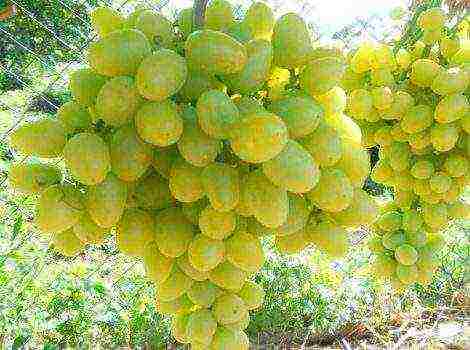Content
- 0.1 Variety Variety - mid-season black currant
- 0.2 Black pearl or Pearl - medium-early large-fruited
- 0.3 Selechenskaya-2 - early fruiting
- 0.4 Black boomer - early harvest from Kharkov
- 0.5 Big Ben - early variety, super yielding
- 0.6 Pygmy - medium early
- 0.7 Raisin - early variety
- 0.8 Gulliver - early maturing
- 0.9 Summer resident - early ripening variety
- 0.10 Titania is a mid-season variety
- 0.11 Dobrynya is a mid-season variety
- 0.12 Bagheera - mid-season
- 0.13 Black currant is the sweetest - Green haze
- 0.14 Nina is an early sweet variety
- 0.15 Bagheera is a mid-season sweet variety
- 0.16 Constellation - early ripening variety
- 0.17 Maria Kievskaya
- 0.18 Nestor Kozin
- 0.19 Exotic
- 0.20 Perun
- 0.21 Dubrovskaya
- 0.22 Crane
- 0.23 Venus
- 0.24 Bummer - late-ripening variety
- 0.25 Arcadia
- 0.26 Vologda
- 0.27 Altai Late
- 0.28 Tatyana's Day
- 1 Varieties
- 2 Early
- 3 Medium varieties
- 4 Late varieties
- 5 Large-fruited varieties
- 6 Sweet varieties
- 7 Choosing varieties for central Russia
- 8 Currant for Siberia
- 9 What are the largest-fruited varieties?
- 10 The most resistant varieties
- 11 Gourmets also have plenty to choose from
- 12 What's new for residents of the Moscow region?
- 13 Conclusion
- 14 Currant varieties
- 15 Red and white currants
- 16 Red currant: varieties
- 17 Large-fruited red currant
- 18 White currant: varieties
- 19 Red currant: benefits
- 20 Red currant harm
- 21 Black currant
- 22 Black currant: varieties
- 23 Large-fruited black currant
- 24 Useful properties of black currant
- 25 Diseases of the currant
- 26 Currant pests
Currant is a tasty and very healthy berry, unpretentious in cultivation and distribution. It is not difficult to cultivate currants, and in order to collect stable good yields on time, you need to choose the right variety that suits you.
Let's look at the possibilities of modern breeding and get acquainted with the varieties that are offered by breeding institutes. Here are the characteristics of various varieties of currants with photos and descriptions.
Black currant varieties with large berries
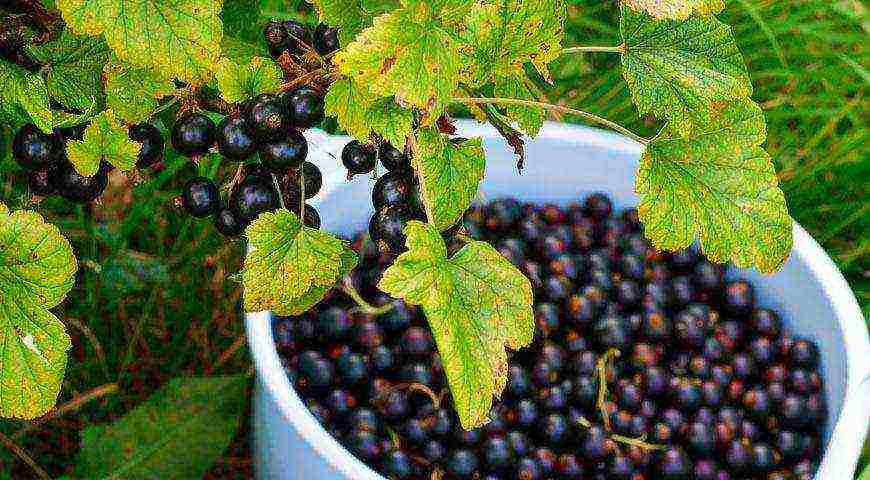
Large varieties of currants attract high yields. Often the berries of these varieties form clusters similar to grapes. In return, they require high-quality cultivation, fertilization, watering, attention and care.
Most large-fruited varieties do not form large enough berries without watering, give reduced yields.
Also, due to the large size, the question arises about the safety of the whole berry. The strength and density of the peel must withstand the pressure of the juice when pouring the berries, as well as ensure keeping quality during transportation and storage.
For the cultivation of large-fruited bushes, agricultural technology is important. The soil under the bushes for the season significantly consumes the supply of nutrients for growing crops.
Also, it is important for large-fruited varieties - that the growth of pagon branches does not lag behind fruiting.
In order for the yields to be stable and annual, timely replacement of the branches of the bush is necessary. Currants bear fruit well on those shoots, the annual growth of which is at least 25 cm. Therefore, branches with a weak growth, the age of which exceeds 4-5 years, must be cut off.
The selection of large-fruited varieties should also take into account the time of maturation of the variety and harvest. Early - bear fruit at the beginning of July. Medium - after the middle of the month, late - in August.
And now, according to the list of varieties and their description, let's see which variety of black currant is the largest and sweetest?
On a note: all varieties described below are winter hardy. They tolerate frosts and prolonged cold weather well, cope with spring return frosts. Therefore, we will not further indicate the characteristics of winter hardiness for each variety separately.
Variety Variety - mid-season black currant

A variety with large berries weighing up to 6 g. Berries are collected in clusters of 8-10 pieces. Thus, the weight of one brush can reach 60 g. And 20 good brushes can make up more than 1 kilogram of the crop.
The yield indicator is 6 kg of berries per bush per year. Their taste is sweet with sourness (they contain 9% sugar and only 3.5% acid - for comparison, in sweet varieties of sugars there is almost the same amount - from 10%), the peel is dense. Bushes grow up to 1.5 m in height.
Yadrenaya is a well-deserved record holder among varieties of large black currants. She needs annual rejuvenation. The branches are severely depleted during the fruiting season, therefore, they require cutting and replacement with new pagons.
What you need to know the disadvantages: the different size of the berries, their size may vary. Another drawback is that the bush is aging and requires replacement after a few years. The number of years of good fruiting depends on the quality of the care. With good soil and sufficient watering, the bushes can retain their yield for 6-7 years.
Black pearl or Pearl - medium-early large-fruited
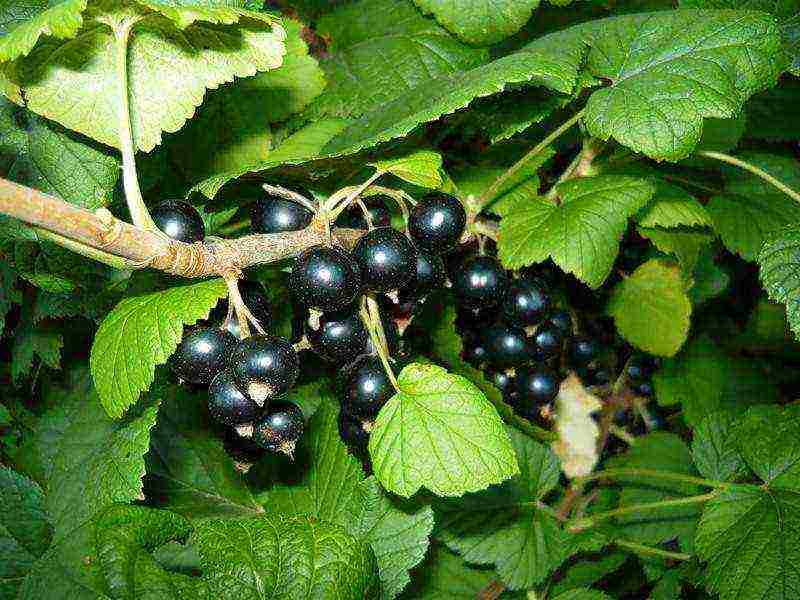
Another record holder who received the title of "Masterpiece of Russian selection". Bred to VNIIS Michurin. Fruits with berries weighing up to 6 g. Taste is sweet with a slight sourness (contains 9.5% sugars). Yields up to 5 kg of berries from each bush.
The name of the variety is associated with the characteristic "pearl" luster. The dense rind ensures keeping quality and the so-called "dry" pull-off. Berries of the Black Pearl are perfectly transported.
The shrub of the variety is distinguished by vertically growing branches, the height of the bushes is up to 1.3 m.Without snow cover, without damage to the future harvest, it tolerates frosts down to -42 ° C. At the same time, it tolerates heat and sun up to +40 without shading.
The advantages of the variety are a good harvest in any year, resistance to mites.
The disadvantage of the variety is that the variety tastes sour, not always resistant to pests, fungal diseases.
Selechenskaya-2 - early fruiting
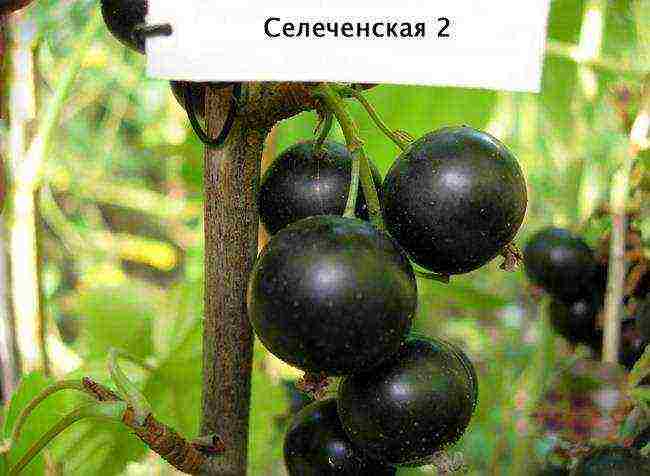
The weight of the berries reaches a maximum of 6 g, they have a sweet and sour taste (7% sugar in the berries) and a dense peel (provides the so-called dry separation and keeping quality). Strong aroma.
There are 10-15 berries per cluster. Very tall dense bushes - up to 2 m, yield up to 5 kg of berries per fruiting season.
Advantages: resistance to both cold and heat and lack of moisture. Not affected by dew.
Disadvantages - the variety requires good care, fertilized soil, and sufficient nutrients. Poorly resistant to pests.
Black boomer - early harvest from Kharkov

The weight of the berries is large, up to 7 g. Collected in a bunch resembling grapes, up to 10 berries in each bunch. The bush is upright and compact, yields up to 4 kg of berry harvest per year.
Advantages: uniformity of ripening and uniformity of berries. Do not crumble after ripening. Stable fruiting every year. Resistance to fungal and other diseases.
Disadvantages: with heavy rains and a lot of moisture, the berries may crack. Pick-off is not always dry.
Big Ben - early variety, super yielding
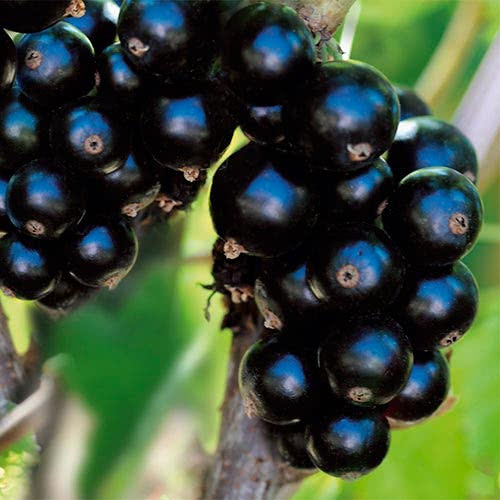
Another variety, the name of which speaks for itself.
Average weight of berries - up to 4 g. The yield of one bush can reach 10 kg (with good care). The taste is sweet and slightly sour, with sweetness prevailing over acid.
Advantages: after ripening, the berries do not crumble. Resistant to frost and powdery mildew.
Disadvantages: exactingness to care - obligatory pruning, fertilization, watering.
Pygmy - medium early
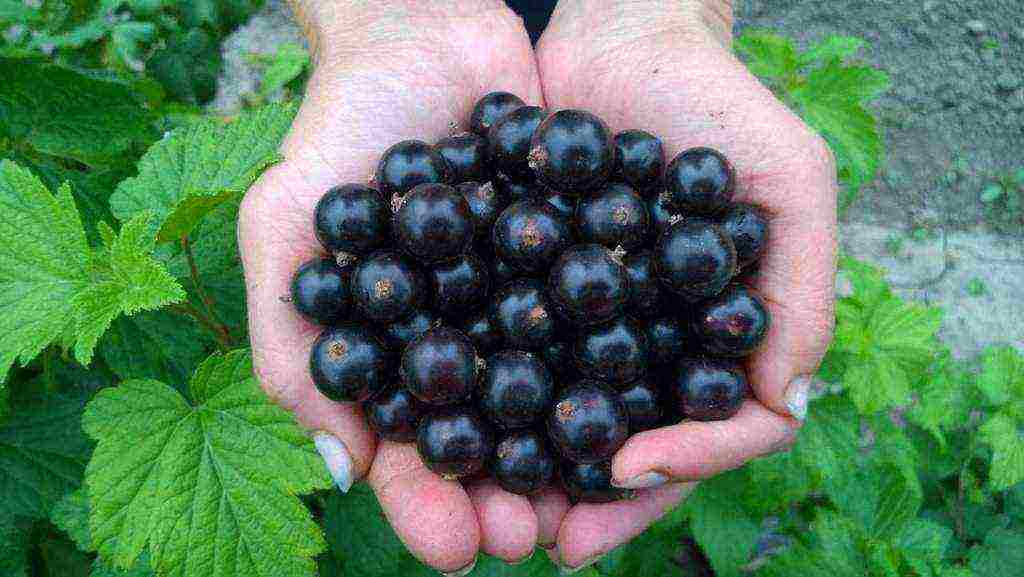
Berries weight up to 8 g, up to 10 pieces per brush. Even over time, with the aging of the branches, the berries retain their large size. The taste is very sweet, it contains 9.5% sugars. The bushes grow up to 2 m high, but the branches are compact, so they do not take up much space.
The variety produces up to 7 kg of berries from a bush per season.
Advantages: the variety is capable of self-pollination and high yields. The bushes are resistant to powdery mildew. Their winter hardiness is determined by thick stems and a large supply of nutrients, it is -35 ° C.
Disadvantages: low resistance to tick and septoria infection.
Raisin - early variety
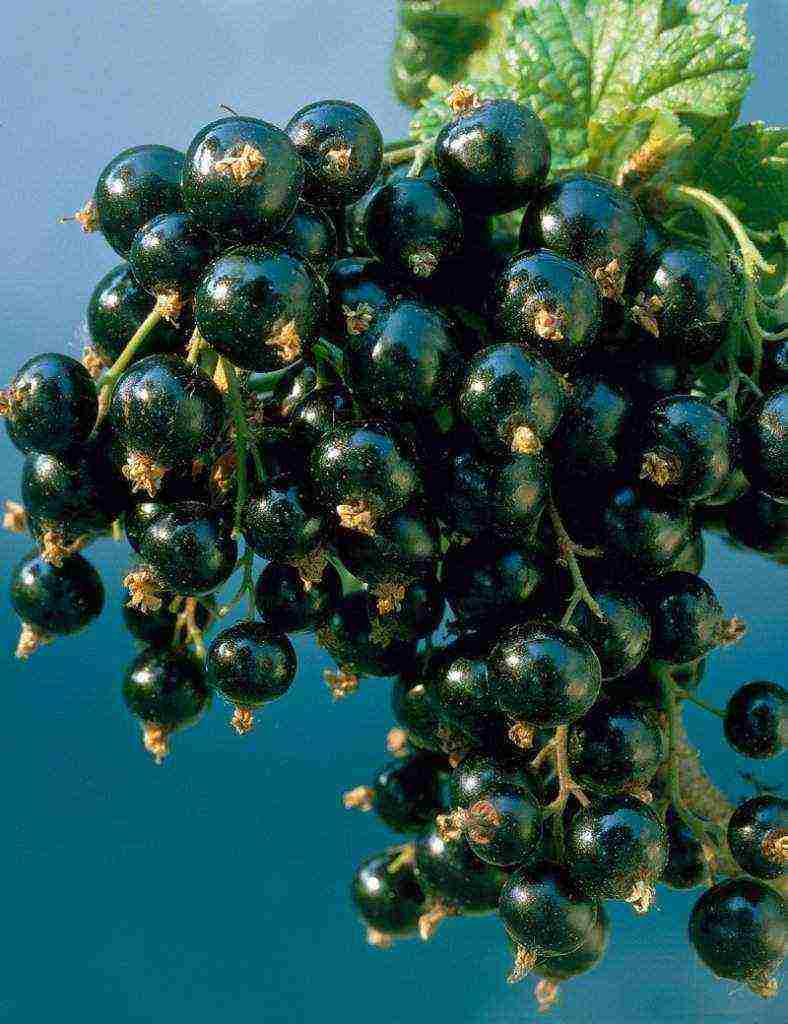
The name of the bush is due to the fact that after ripening the berries do not crumble from the bush, remain on the branches, wither and turn into a kind of raisins. This is the exclusive properties of the raisin variety.
Berries differ in average weight - up to 4 g, in a brush there can be 10-12 sweet berries, in which up to 9% of sugars. Productivity - average, 3.5 kg per bush. The direction of growth of pagons is upward. Thanks to this feature, the bushes can be planted denser than usual.
Ripening period - early. The taste is sweet.
Advantages: winter hardiness and resistance to heat, fungal infections, ticks.
Disadvantages: poor rooting, bushes of this variety are more difficult to propagate by cuttings, unlike most traditional black currant varieties.
Gulliver - early maturing
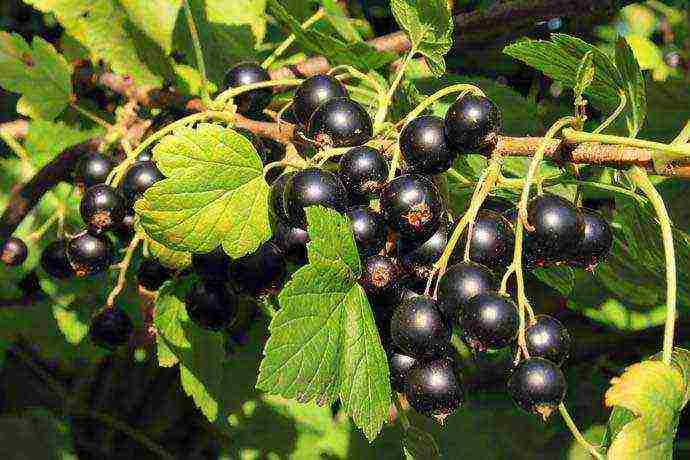
The weight of Gulliver berries reaches 5 g. Considering that there can be 20 berries in the bunch of this variety, the weight of the bunch turns out to be weighty - up to 100 g. The taste of berries is rich, with a well-felt sourness. Sugar in berries 6.5%. The bush is tall and leafy, yields up to 2 kg per year.
Advantages: the variety is resistant to very severe cold and long spring frosts. Resistant to kidney mites.
Disadvantages: picky about light, bears fruit well in open sunny places when watering. Lack of water is reflected in a decrease in the amount of crops.
Summer resident - early ripening variety
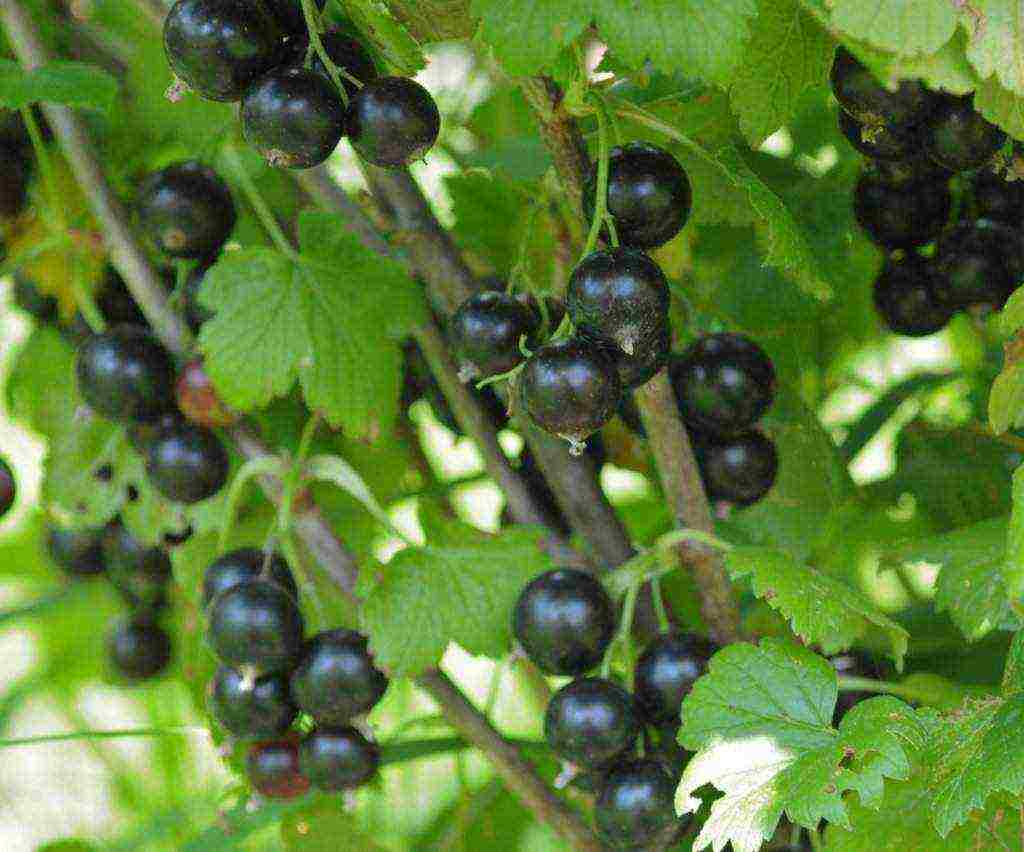
The size of the berries is large enough - up to 5g, very sweet, contain 9.3% sugars. The total yield of the bush is average, up to 1.5 kg of berries per year. The bush is undersized, withstands frosts down to -35 ° C.
Advantages: high self-fertility (more than 70%, in most varieties - about 50%, and this is considered a good indicator).
Disadvantages: due to the short stature, the branches during the ripening of the crop can bend low to the ground and touch the ground. Therefore, props and timely harvesting are needed. Berries not picked on time quickly crumble. The fruits ripen unevenly.
Titania is a mid-season variety
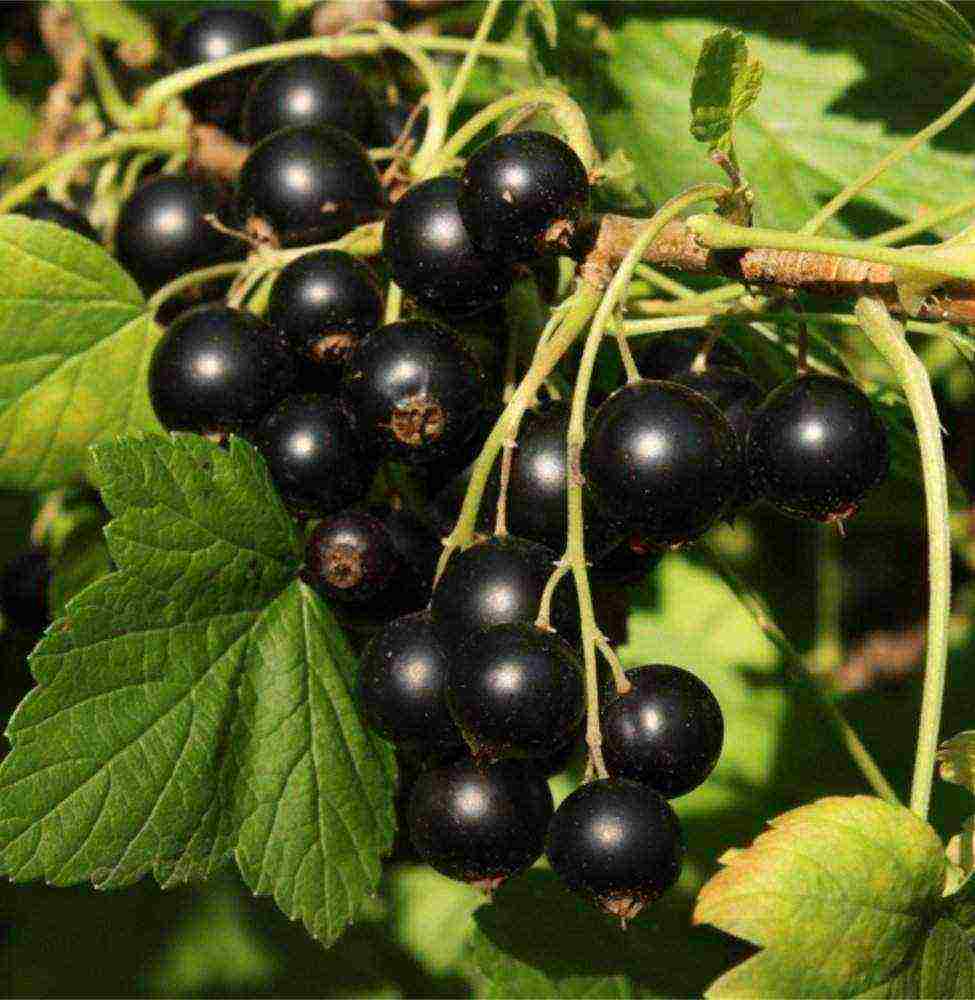
Despite the name, the variety bears fruit with medium-sized berries. The weight of each berry does not exceed 4 g. However, with a large number of berries in the bunch (up to 25 pieces), the yield of the variety is quite high - 4 kg per bush per fruiting season.
The taste is traditional sweet and sour (there are not so many sugars, only 6.5%). Another feature of the variety is that the berries ripen in batches within 3 weeks. Which is convenient for home assembly and inconvenient for a mechanized one.
The advantages of the variety: resistance to cold climates and diseases, tolerates frosts down to -24 ° C without loss of yield, does not choke when harvested.
Disadvantage: the variety requires good care - fertilizers, watering, pruning, timely replacement of bushes.
Dobrynya is a mid-season variety
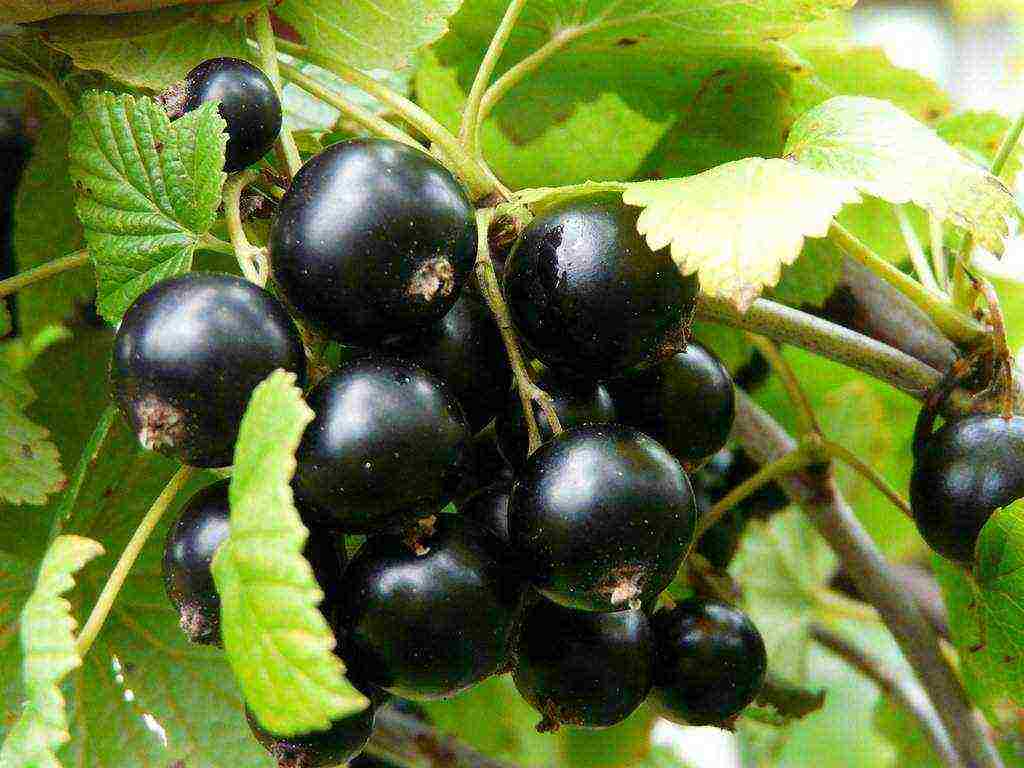
A fairly large variety with a weight of each berry up to 7 g. Each cluster contains 8-10 berries. Up to 3 kg of harvest is harvested from each bush. Sweet and sour taste with an average sugar content of 7%, dense peel provides transportability and shelf life.
The height of the bush is up to 1.7 m with a compact, non-spreading crown. This makes the variety popular for summer cottages in small, confined areas.
Advantages: high winter hardiness, not afraid of long and severe frosts, resistance to adverse factors - drought, powdery mildew, without loss of yield.
Disadvantages: different sizes of berries, exactingness to care, low resistance to fungal diseases.
Bagheera - mid-season
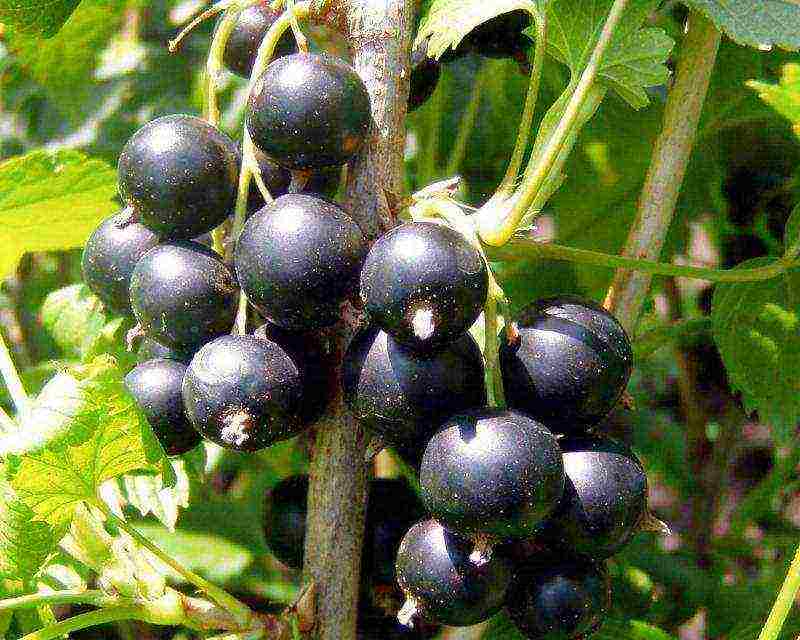
Berries weighing up to 7 g, 7 pieces per brush. Very sweet, contains 12% sugar. The bushes are tall, reaching 2 m. With good care, 4.5 kg of berries are harvested from each bush.
Advantages: the variety is equally adapted to cold and heat, frost and drought, suitable for growing in a harsh continental climate. And also resistant to pests.
Sweet varieties of black currant
Sweet currant varieties contain more than 10% sugars. However, they also contain vitamin C (ascorbic acid).The amount of vitamin C determines the sourness of the variety - whether it will feel strong, or weak, barely noticeable.
As a rule, sweet black currant varieties have almost no sour taste. Therefore, they represent a tasty prey for wasps. For such varieties to ripen, natural protection is needed - a dense peel on the berry. Otherwise, the crop will be stably destroyed by wasps.
The sweetest varieties of black currants contain more than 12% sugars. Their taste is reminiscent of grapes, and the sweetness is provided by the name of the varieties - dessert. For information on the characteristics of black currants (various varieties: super large, sweet and fruitful) - see below on the description and photo.
Black currant is the sweetest - Green haze
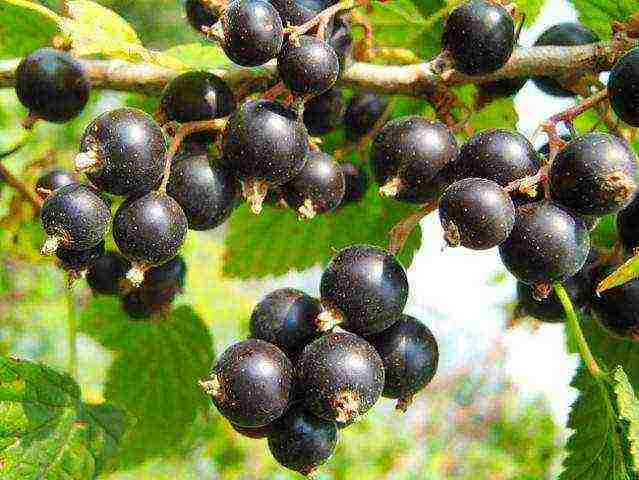
A short bush, the berries of which contain up to 13% sugars. Ascorbic acid in them - 200 mg per 100 g.
The size of the berries is medium, up to 2.5 g. High productivity of the bush - up to 7 kg of berries per season.
Disadvantage: poorly resistant to ticks.
Nina is an early sweet variety
The variety, in the berries of which up to 11% sugars and up to 270 mg 100 g of vitamin C. Berries up to 4 g, bushes consistently bear fruit up to 4 kg over the summer. They are demanding for watering, in which they grow berries twice as large - up to 8 g each. Moreover, all berries are the same size. Easily propagated by cuttings.
Disadvantage: poor transport stability.
Bagheera is a mid-season sweet variety
A variety in which up to 12% sugar and up to 190 mg 100 g of ascorbic acid. The characteristics of the variety are given above, we will repeat them. Berries weighing up to 7, bush yield up to 4.5 kg. Ripen at once, suitable for farming.
Disadvantage: low resistance to dew and pests.
Constellation - early ripening variety
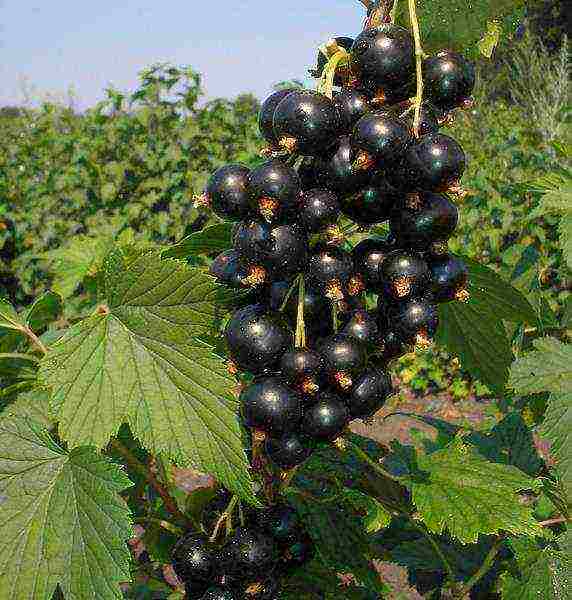
The weight of the berries is small, reaching 1.5-2 g, the sweet taste is provided by 11% of sugar in the pulp. The total yield is also average - about 2.5-3 kg per bush.
The bushes are medium-sized and slightly spreading. Branches are of medium thickness.
Advantages: the ability to bear fruit even without watering. Bushes give 3 kg of berries, even in the "worst" for growing, dry seasons. Also important: self-fertility, winter hardiness, resistance to pests and diseases.
Disadvantages: poor resistance to kidney mites.
Early varieties of black currant
Ripe berries are yielded in early July, and in the southern regions - in the middle and second half of June. For early varieties, spring frost resistance is important. They wake up early (at least April), bloom (usually in May) and more than other medium and late varieties suffer from recurrent frosts or spring cold snaps.
The early maturing varieties Dachnitsa and Selechinskaya were described above. Here are the characteristics of other varieties.
Maria Kievskaya
Berries up to 4 g, sweet and sour. Used for processing and freezing. Medium-sized spreading bushes.
Advantages: resistance to one of the common diseases of shrubs - rust, resistance to powdery mildew.
Nestor Kozin
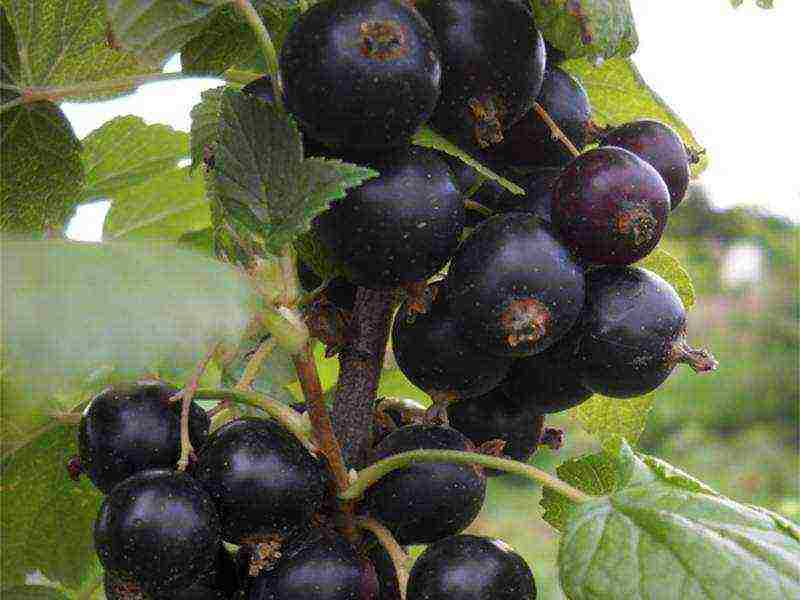
Berry up to 4 g, sweet. The height of the bush is up to 1.5 m.
Advantages: resistant to frost, heat, powdery mildew.
Exotic

Berries up to 3 g with sweet and sour taste. They grow on medium-sized bushes with a yield of 1.5-2 kg per year.
Advantages: bushes are not prone to thickening.
Advantages: resistance to the appearance of powdery mildew, resistance to winter cold. The keeping quality of the berries after picking.
Disadvantages: relatively low yield - up to 1 kg per bush.
Perun
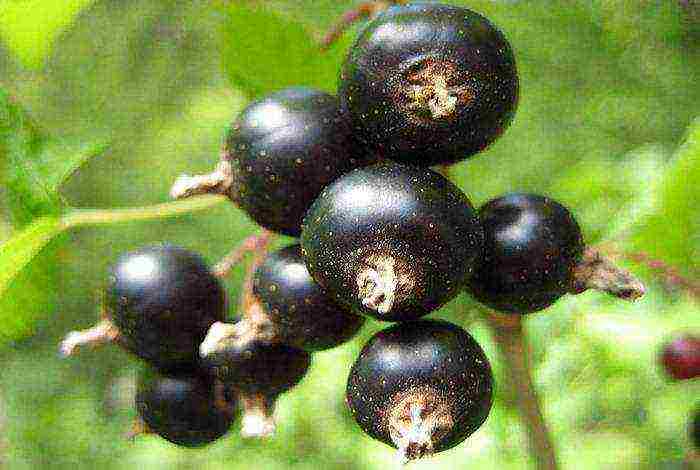
Berries weight up to 2 g. Collected in a brush of 10-14 berries. Harvest from a bush - up to 2 kg. The taste is sweet with a slight sourness, 9.5% sugars, and a very strong aroma.
Advantages: resistance to winter and return frosts, to heat.
Disadvantage: it suffers greatly from powdery mildew, requires a garter of branches on a trellis.
Medium black currant varieties
Medium varieties ripen in late June and early July. Medium late - the second decade of July. They are popular due to the content of a large amount of nutrients.Among the representatives of mid-season varieties are the bestsellers Yadrenaya, Dobrynya, Izyumnaya.
Here are a few mid-season varieties.
Dubrovskaya
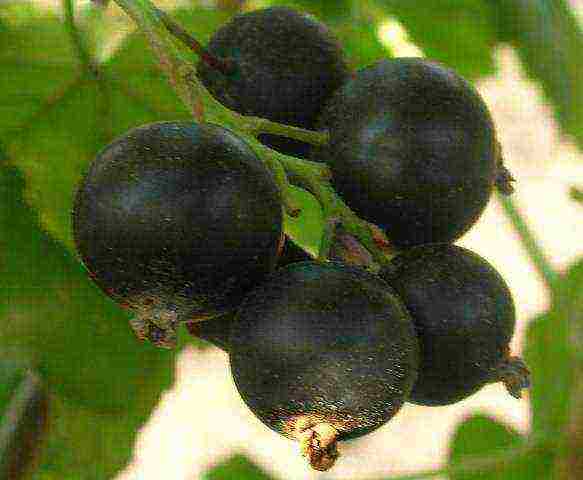
A variety that combines a high yield per bush (up to 3 kg) and its small compact size. Therefore, it is ideal for small summer cottages. The weight of the berry on the bush reaches 2.5 g, the taste of the berries is sweet and sour (they contain 7% sugars).
Advantages: resistant to cold weather, mites and terry.
Disadvantages: the bushes are prone to thickening, often affected by powdery mildew.
Crane
Berries are medium in size (up to 1.5 g each), rather sweet in taste (contain up to 10.5% sugars). Spreading bushes, yield up to 4 kg per year.
Advantages: the berry is dense, transportable, suitable for mechanized harvesting.
Venus
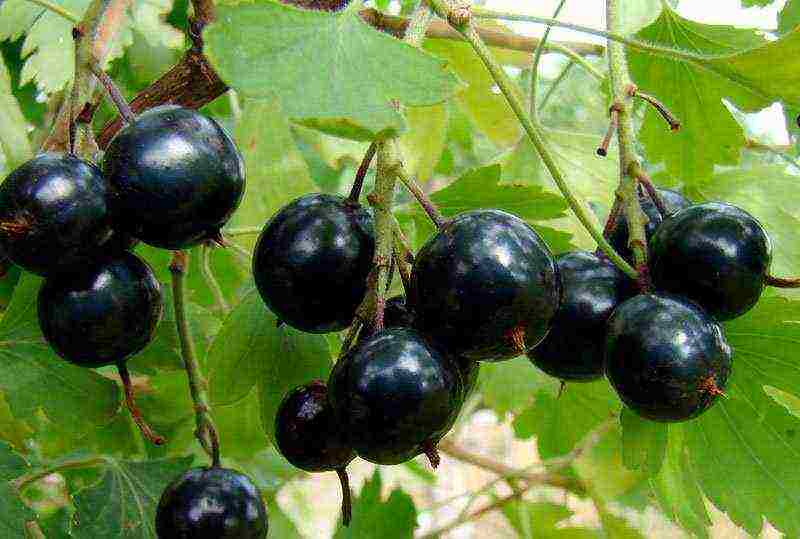
Berries up to 6 g, in a brush up to 10 berries, contain about 7% sugars - sweet and sour taste. Collect up to 5 kg from the bush. Good winter hardiness and drought resistance. Grows well and bears fruit in partial shade.
Advantages of the variety: begins to bear fruit early and extends the fruiting time to August.
Disadvantage: low resistance to mites, septoria and hazel grouse. Poor transport stability.
Late varieties of black currant
Ripen in early August. Often they are affected by fungi, pests due to prolonged aging. Therefore, for late varieties, resistance to diseases, pests, resistance to heat, and lack of water in the soil are important.
For a long time of ripening, throughout the season, the bushes are exposed to various "misfortunes". They must successfully survive the lack of moisture, release new pagons and grow a consistently high berry yield.
Also important: for a long ripening, the berries need a dense peel. It shouldn't crack. Such berries are excellent for transportation, they are not damaged during mechanized picking. It is also convenient to freeze them. Here are the characteristics of popular late-ripening varieties.
Bummer - late-ripening variety
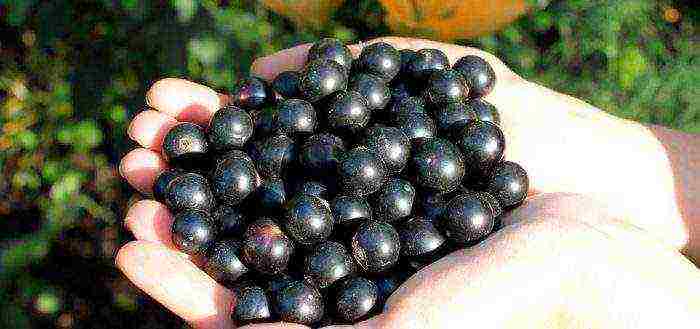
Berries up to 3 g, sweet (more than 9% sugar), collected in medium-sized clusters, 8-10 berries each. The yield indicator is average - 2.2 kg of ripe berries from a currant bush per season. The bushes themselves are tall, dense, medium spreading.
Features of agricultural technology - suitable for mechanized assembly.
Advantages: frost resistance and resistance to pests, fungal diseases, except for dew.
Disadvantages: instability to powdery mildew, gradual ripening, unstable yield.
Arcadia
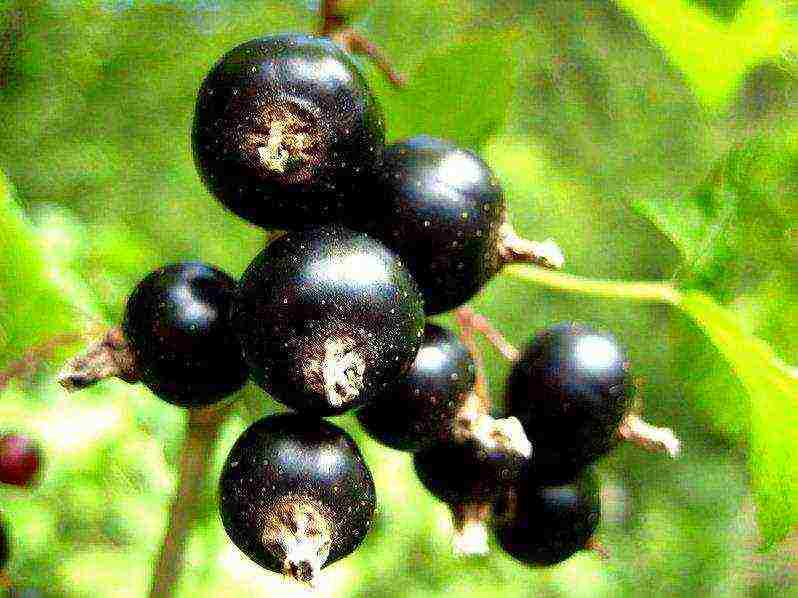
A variety with fairly large sweet and sour berries, the weight of which reaches 5 g. The yield per bush is average and is 2.5 kg. The bush is 1-1.2 m with curved branches.
The variety has a disadvantage, traditional for low bushes: under the weight of the harvest, the branches fall to the ground.
Vologda
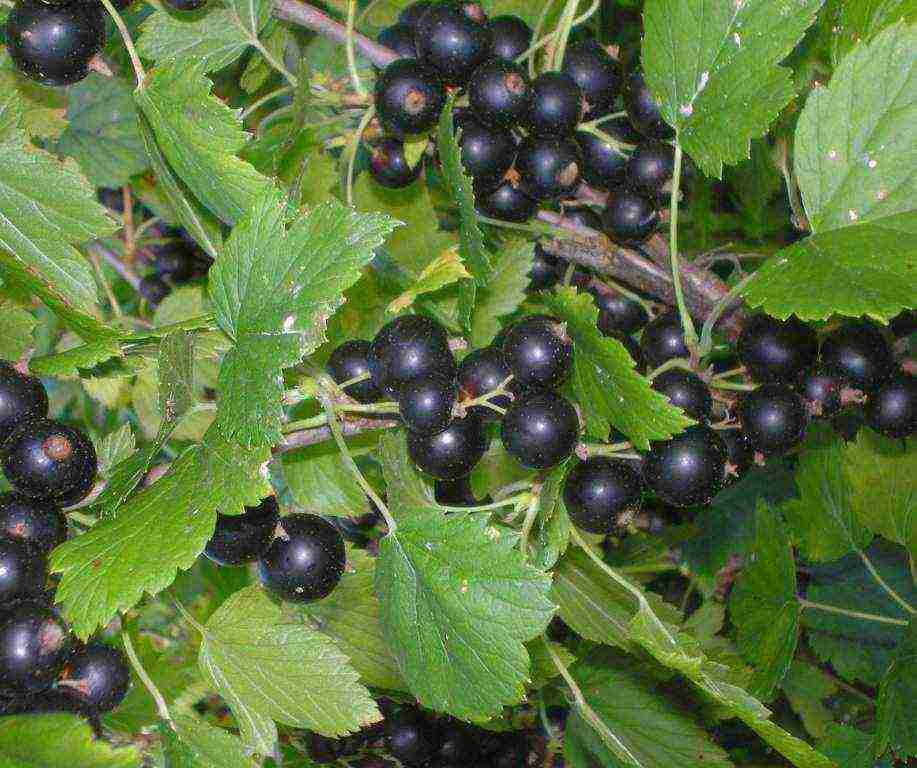
Yield leader among late varieties. Yields 5 kg of berries from a bush, weighing more than 2.2 g. Berries grow in clusters of 40 for easy harvesting. Sprawling bush, withstands cold up to -35 and heat up to +45.
Disadvantage: Prone to rust, uneven maturation, requires garter.
Altai Late
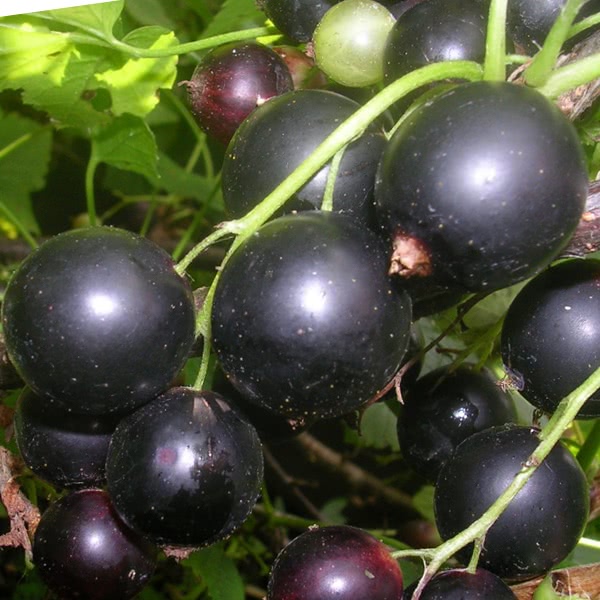
Produces berries of medium size - up to 1.2 g in weight, collected in 10-14 pieces per cluster. The sweetness of the taste is provided by 8% of sugars.
The variety is resistant to various fungi and pests, except for powdery mildew.
Tatyana's Day
Sufficiently sweet (9.5% sugar) and medium-sized (up to 1.5 g) berries. Up to 3 kg of harvest ripens on the bush. Suitable for mechanized assembly.
Disadvantage: not resistant to spider mites and powdery mildew.
There are a great many varieties of black currant. But from all this variety, you need to choose exactly those that are suitable for the site where they will grow. Each variety is good in its own way, but not everyone will grow well in certain climatic conditions. Some species mature early.
There are medium and late varieties that start bearing fruit somewhat later. Caring for different types of culture also differs.Everyone wants to simultaneously have good harvests of berries in combination with large sizes of fruits and their excellent taste.
This article describes the best blackcurrant varieties for central Russia, their features and photos, as well as advantages and disadvantages, which will help gardeners, especially beginners, to make the right choice, on which the quality and quantity of the future harvest will depend.
Varieties
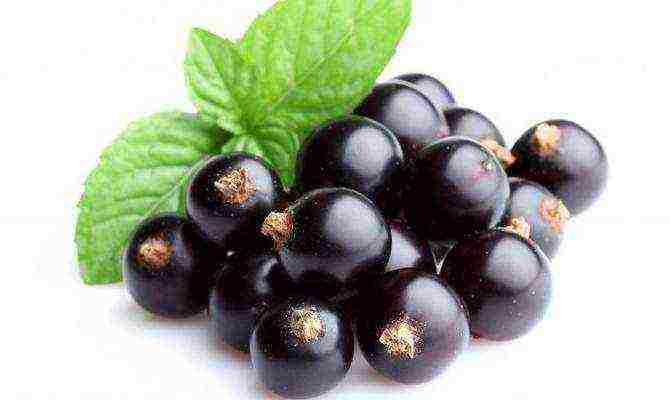
For cultivation in the middle lane, there are a huge number of varieties of black currant, which will not be enough to list and describe in one article. For different sites with their individual characteristics, it is rather difficult to choose a suitable variety from such an abundance of species, however, this must be done.
The best varieties of black currant can be safely attributed to:
- Raisin;
- Summer resident;
- Selechinskaya 2;
- Exotic;
- Dubrovskaya;
- Black Pearl;
- Titania;
- Pygmy;
- Bagiru;
- Vologda;
- Mermaid;
- Dobrynya;
- Nuclear;
- Nina;
- Excellent student.
They are divided into:
- early varieties;
- medium;
- late.
And also on:
- large-fruited;
- sweet.
Early
Early types of black currant begin bearing fruit from the end of June. Of the early types of berries, the most popular are:
- Raisin;
- Summer resident;
- Selechinskaya 2;
- Exotic.
- Raisin
Variety Raisin
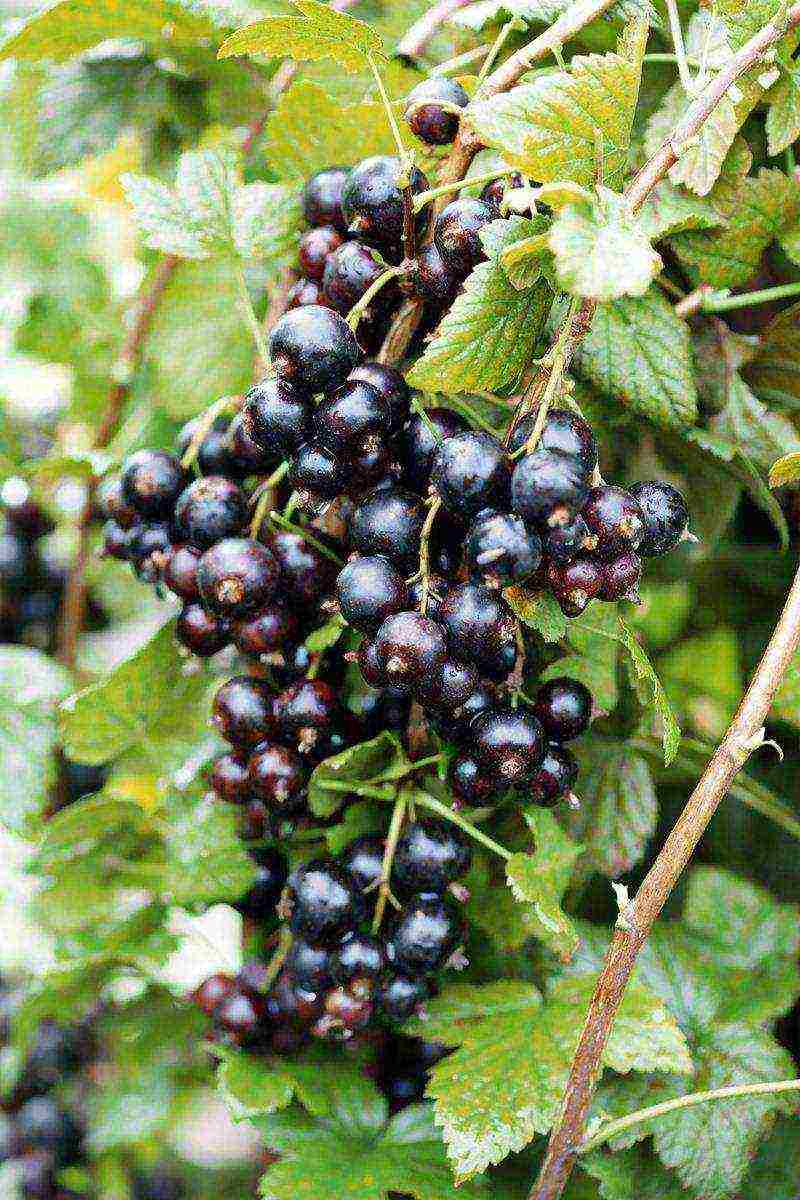
It was withdrawn at the end of the last century. In 2007 it was entered in the State Register for cultivation in the Central regions of Russia.
Raisin bushes are upright, medium-sized. Leaves are three-lobed, large, dark green in color, with a convex leathery matte plate. Flowers - pale yellow, large, collected in a brush.
Berries are round, large (up to 3.2 g), black, matte. The taste of the fruit is sweet, full-bodied.
100 g of berries contains:
- sugars - 9.1%;
- vitamin C - 192 mg;
- acids - 1.8%.
Productivity - up to 3.5 kg per bush.
The berries do not crumble, which is very pleasing to gardeners who come to their plots only on weekends. Fruits ripen early - at the end of June you can feast on aromatic sweet berries.
The variety is frost-hardy, tolerates drought well. Excellent resistance to diseases (kidney mites, powdery mildew, fungal diseases).
The advantages include:
- winter hardiness;
- resistance to weather disasters;
- large-fruited.
Flaws:
- poor rooting by lignified cuttings.
Summer resident
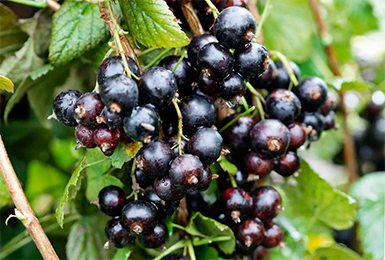
The early Dachnitsa variety is one of the most popular in Russia. It was withdrawn in 2004. Then it was entered in the State Register for cultivation in the Volgo-Vyatka and North-West regions of the country.
The bushes of the variety are compact, low, of medium density, spherical in shape. Young shoots are shiny, not pubescent, green in color. Older shoots are gray-brown with a brown top. Five-lobed, corrugated, medium-sized leaves, have a green, bronze tint, color. Flowers of medium size are pale, inconspicuous.
The fruits of the variety are large enough. The mass of one berry is 2 or more grams.
There are super-large specimens up to 5 g. The color of the berries is black. The thin skin is almost invisible when eaten. The pulp is juicy, rich, the taste is harmonious, sweet, with a pronounced aroma.
100 g of berries contain:
- sugar - 9.3%;
- vitamin C - 193.6 mg.
On a five-point scale, the taste of the Summer Resident is estimated at 4.6 points.
The variety is early. Plants begin to bloom in May, and at the end of June the first berries ripen.
The self-fertility of this type of currant is very high, however, if you plant other varieties of crops nearby, then the yield of the Summer resident will increase several times.
The yield is high. More than 1.5 kg of fruit can be harvested from one bush.
The advantages of the variety include:
- early onset of fruiting (in the third year, the first crop appears, the peak of which
- falls on the age of the bush 5-8 years);
- high productivity;
- excellent taste;
- self-fertility;
- high frost resistance;
- resistance to diseases and pests (powdery mildew and kidney mites).
The Summer Resident also has disadvantages:
- if the berries are not removed in time, they will become soft and crumble;
- with a large load of fruits, the branches bend down, and sometimes even break.
Selechenskaya 2
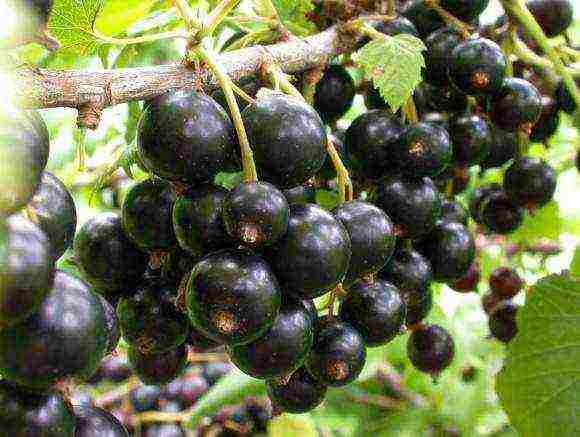
Selechenskaya 2 was withdrawn in 2000. Recommended for cultivation in the Central Region, North-West and West Siberian Districts.
Bushes - tall, erect. The leaves are three-lobed, dark green in color, leathery, wrinkled, boat-shaped. Light, red-violet flowers are collected in bunches of 800 pieces.
Large black berries weighing up to 4.5 g, densely located on the branches. The pulp is greenish in color, fragrant and tender, has a sweet taste with some sourness.
Composition of 100 g of pulp:
- sugar - 7.3%;
- acids - 2.2%;
- vitamin C - 160 mg.
Taste qualities on a five-point scale are estimated at 4.9 points. Ripening is early. At the end of June, you can taste the first berries.
Bushes begin to bear fruit already in the second year, and by 3-4 years up to 5 kg of berries are harvested from one plant.
Advantages:
- high productivity;
- excellent taste (the variety is considered almost the most delicious);
- anthracnose and powdery mildew resistance;
- large-fruited;
- good winter hardiness.
Flaws:
- relative resistance to kidney mites;
- instability to damage by aphids.
Exotic
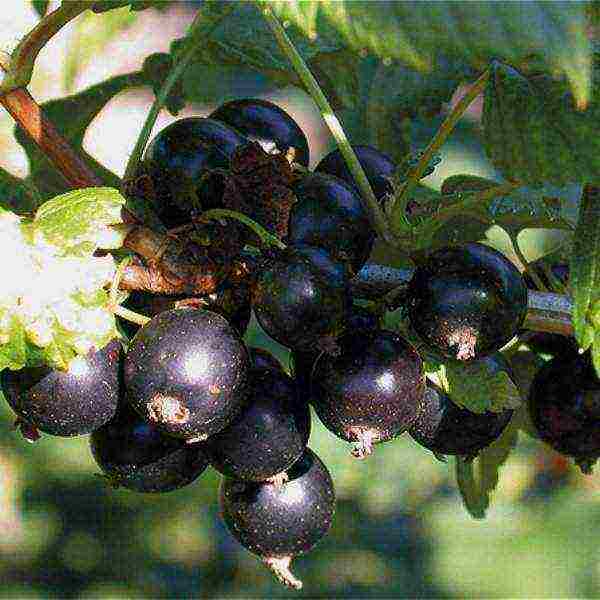
The variety was registered in the State Register in 2001 for cultivation in the Central region of Russia.
Upright and hardy plants - vigorous, sturdy, with strong branches of medium thickening. Leaves are five-lobed, large, dark green in color. White large flowers are collected in clusters. The berries are very easy to pick, as they are arranged in massive bunches similar to grapes.
The fruits of the variety are large. One berry reaches a mass of 5 or more grams. Their color is black, their shape is rounded. The pulp is fragrant, juicy, has a sweet and sour pronounced taste. The skin is thin, not felt when eating.
100 g of berry pulp contains:
- sugar - 8.9%;
- vitamin C - 198 mg.
The flowering of the bushes begins in May, and the first fruits ripen in June. The variety has high self-fertility, excellent winter hardiness (up to -25 degrees) and resistance to diseases, in particular, to columnar rust and powdery mildew. Productivity is quite high (more than 3 kg of berries per bush).
Advantages:
- high productivity;
- good frost resistance;
- large-fruited;
- excellent taste;
- powdery mildew resistance;
- good self-fertility.
Flaws:
- poor transportability;
- vulnerability to dry weather;
- during harvesting, mechanical damage is possible due to the presence of too thin
- peels on fruits:
- hypersensitivity to lesions with septoria, anthracnose, terry, kidney mites.
Medium varieties
Fruiting of medium varieties begins in mid-July. The average includes:
- Dubrovskaya;
- Black Pearl;
- Titania;
- Pygmy.
A characteristic feature of these varieties is the large berry size and long-term fruiting.
Dubrovskaya
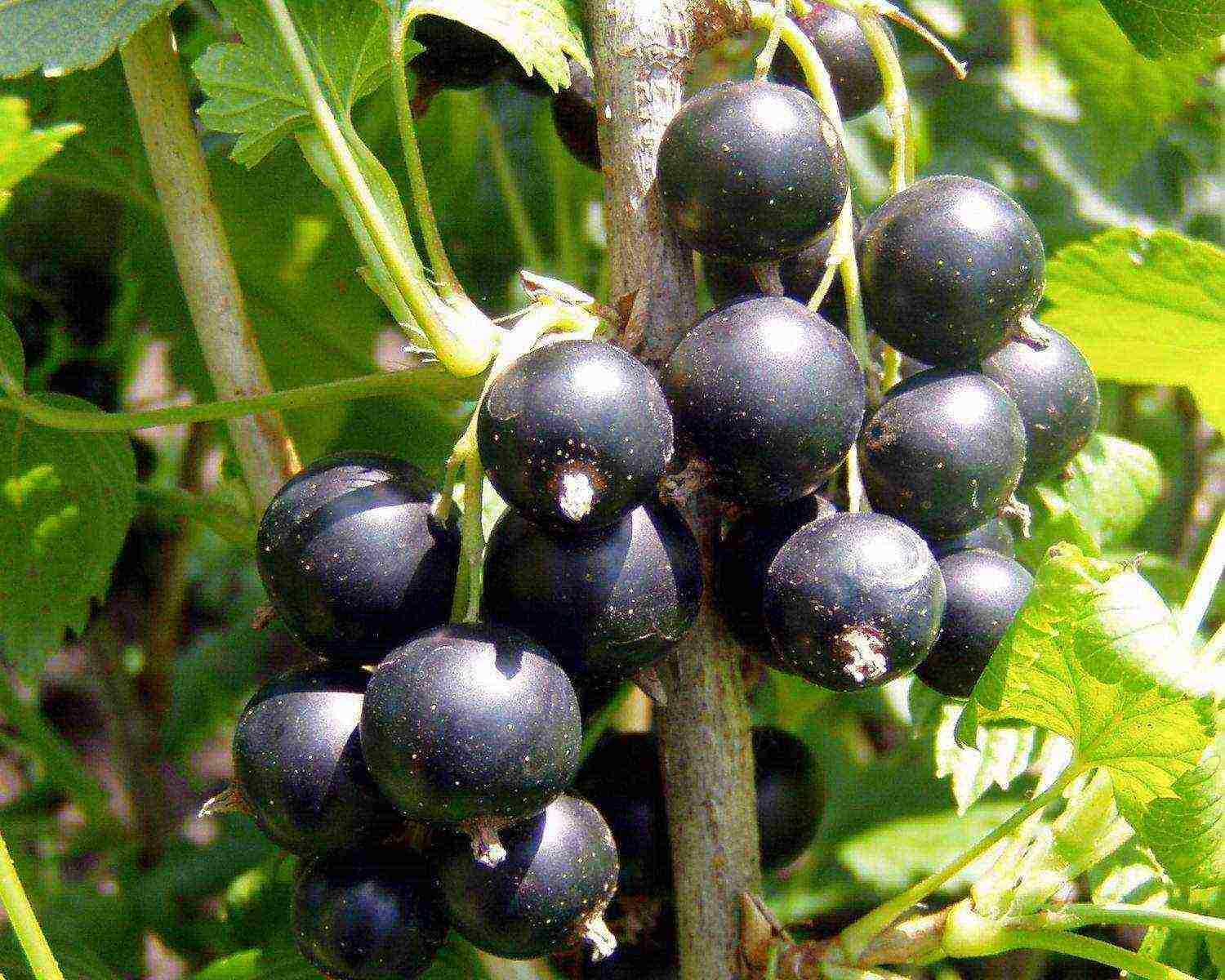
The variety was bred in 1988, and since then it has been successfully grown in the territories of the Volgo-Vyatka and Central regions.
Bushes of the species are medium-sized and compact, beautifully shaped and of medium density. Leaves are juicy green, leathery and wrinkled, medium in size. The flowers are small in size, light green in color, resembling cups in shape.
The berries are black and regular in size. The mass of one berry is 2.3 g. The taste of the fruit is rich, sweet and sour. Ripen in mid-July.
100 g of fruit contains:
- sugar - 7.2%;
- acids - 2.0%;
- vitamin C - 200.4 mg.
On a five-point system, taste can be estimated at 4.5 points.
Dubrovskaya is a very productive variety. Up to 3.8 kg of juicy berries are harvested from one bush.
This type of black currant is characterized by high frost resistance, good self-fertility, sufficient resistance to kidney mites.
The advantages include:
- high productivity;
- large-fruited;
- self-pollination;
- good taste;
- resistance to kidney mite damage.
Flaws:
- increased incidence of anthracnose, powdery mildew;
- tendency to overgrowth and thickening.
Black Pearl
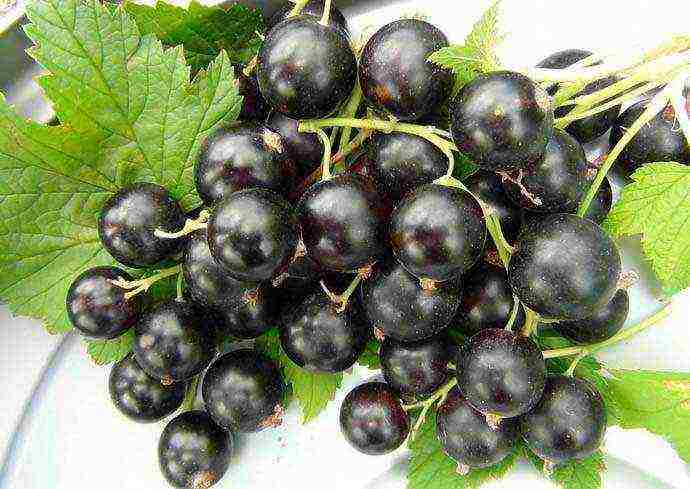
Bred Black Pearl in 1992. The variety is successfully cultivated in the Middle Volzhsky, Central Black Earth regions, in the North Caucasian District.
The bush of the variety is medium-sized with a small number of branches of weak thickening. Leaves are five-lobed, light green, with curved edges. Flowers, goblet-shaped, medium-sized, collected in a brush.
Fruits are round, black, glossy, of color, rather large (weighing 6 g). The pulp is juicy, sweet and sour, with large seeds. The fruits reach maturity by mid-July.
Composition of 100 g of berries:
- sugars - 8.0%;
- acids - 1.7%;
- vitamin C - 133 mg.
On a five-point scale, taste is rated at 4.2 points.
The variety has good transportability and keeping quality, as well as high yield, up to 3 kg per bush. Black pearls are hardy and moderately resistant to powdery mildew.
Advantages:
- good productivity;
- high taste and presentation;
- decent frost resistance;
- the variety can be transported over long distances without losing its taste and presentation.
Flaws:
- sour taste that not everyone likes;
- medium resistance to powdery mildew.
Titania
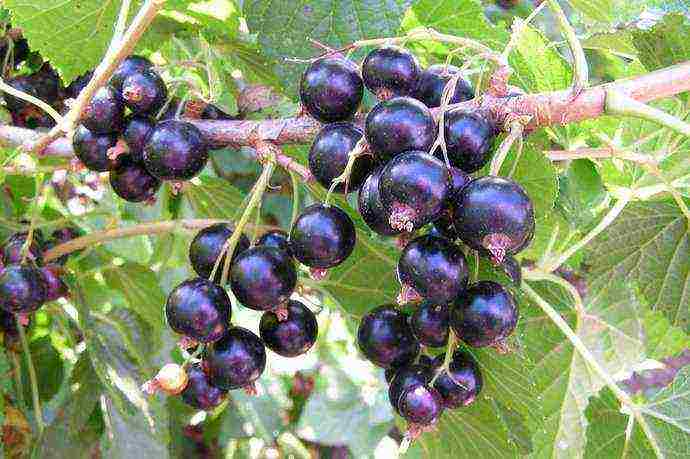
The variety was bred by Swedish breeders in 1970. It appeared in Russia in 1995.
Titania is characterized by the fact that the branches of the plants are directed upwards. The bush itself resembles the shape of a ball. Leaves are medium in size, wrinkled, bright green in color.
Fruits are black, large (up to 4 g in weight). The pulp is dark green, juicy. Taste - sweet and sour, dessert, with wine notes.
Composition 100 g:
- sugar - 6.6%;
- acids - 3.2%;
- vitamin C - 170 mg.
On a five-point scale, taste is rated at 4.7 points.
Titania has excellent transportability and keeping quality, which allows it to be cultivated on an industrial scale. The yield of the variety is up to 3.5 kg per plant.
Advantages:
- high frost resistance;
- large-fruited;
- consistently high yields;
- lack of shedding;
- good transportability;
- high resistance to morbidity.
Flaws:
- tendency to overgrow;
- chopping berries in the absence of care;
- high requirements for soil moisture and nutrient composition.
Pygmy
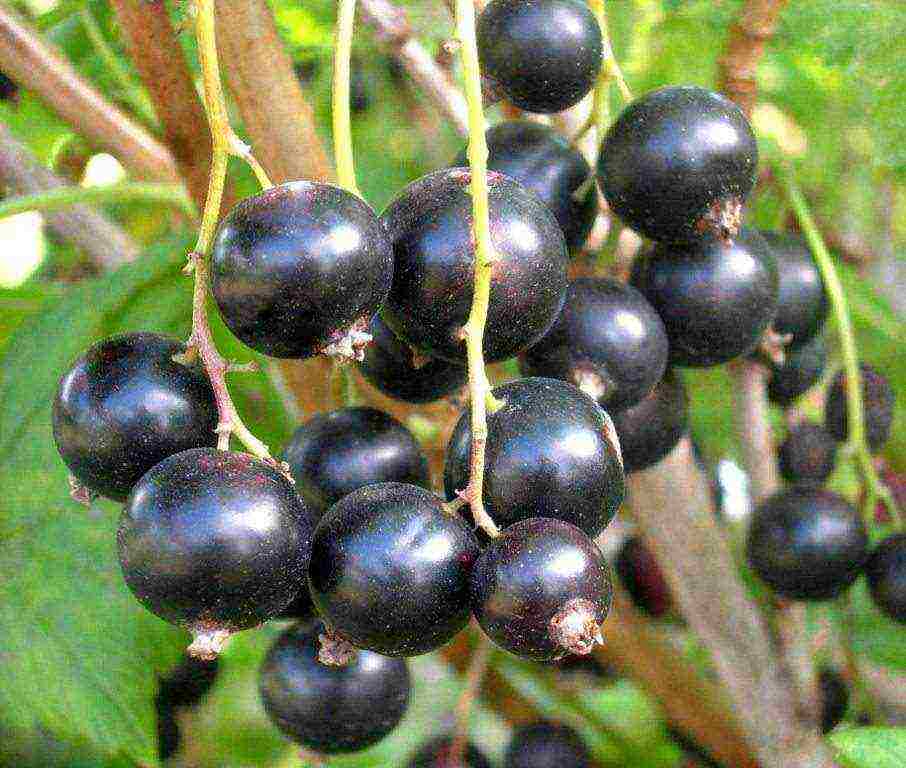
Pygmy was created in 1999 and is cultivated in the Volga-Vyatka, West Siberian and Ural regions.
The bush is compact, medium spreading, medium thickening. The leaves are bright green, wrinkled, large in size. Flowers - small, pale, similar to saucers, collected in brushes.
Berries are black, shiny, very large (up to 7.5 g), have a sweet taste and rich aroma. The variety gives amazing yields - up to 5.7 kg per bush.
Composition 100 g:
- sugar - 8.7%;
- vitamin C - 170 mg.
Pygmy has an amazing frost resistance (up to -32 degrees), high self-fertility, resistance to anthracnose and powdery mildew. It is characterized by long-term fruiting and unpretentious care.
Advantages:
- drought tolerance;
- self-fertility;
- frost resistance;
- high productivity;
- large-fruited;
- sweet taste;
- resistance to anthracnose and powdery mildew.
Flaws:
- vulnerability to kidney mites and septoria.
Late varieties
The late varieties include those that begin to bear fruit from the end of July and continue to ripen until the end of August.
Of these, it can be noted:
- Bagiru;
- Vologda;
- Mermaid.
Bagheera
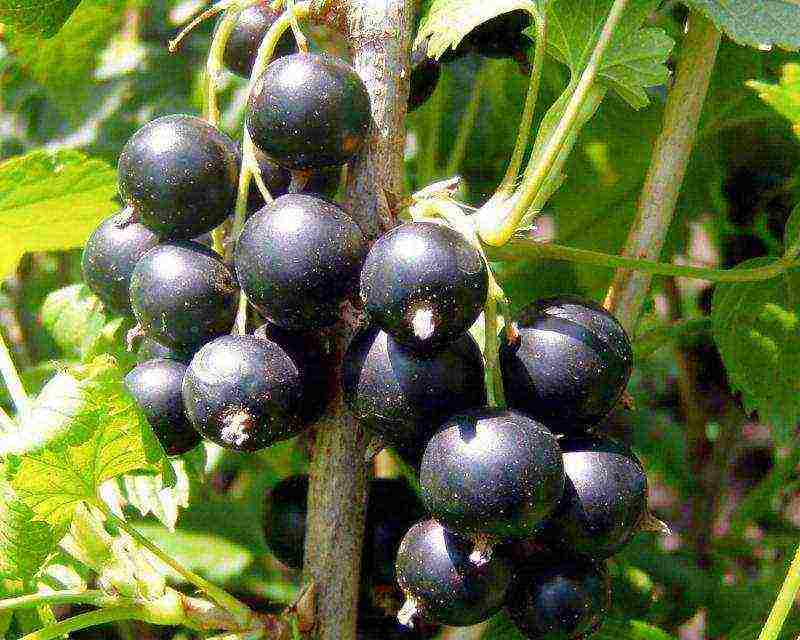
The variety was included in the State Register in 1990 for cultivation in the North-West, Volgo-Vyatka, Ural, Middle Volga, West Siberian and East Siberian regions.
The bushes are medium-sized, characterized by rather rapid growth. Plants shed their foliage late.
Leaves are five-toed, light green, matte, with wavy edges. Flowers - medium-sized, goblet-shaped.
Berries are black in color, medium in size (weighing up to 2 g) have a juicy tender pulp, sweet taste, with a pleasant sourness.
100 g of pulp contains:
- sugar - 12%;
- acids - 3.5%;
- vitamin C - 190 mg.
Productivity - up to 4.5 kg per bush. It tolerates both cold and heat well. It has a high, up to -32 degrees, frost resistance, and an average resistance to pests and diseases. It is perfectly transported over long distances without losing its marketability and taste.
Advantages:
- early maturity;
- good self-fertility;
- high productivity;
- decent frost resistance and drought resistance;
- excellent transportability and keeping quality.
Flaws:
- insufficient resistance to kidney mites and powdery mildew;
- vulnerability to direct sunlight.
Vologda
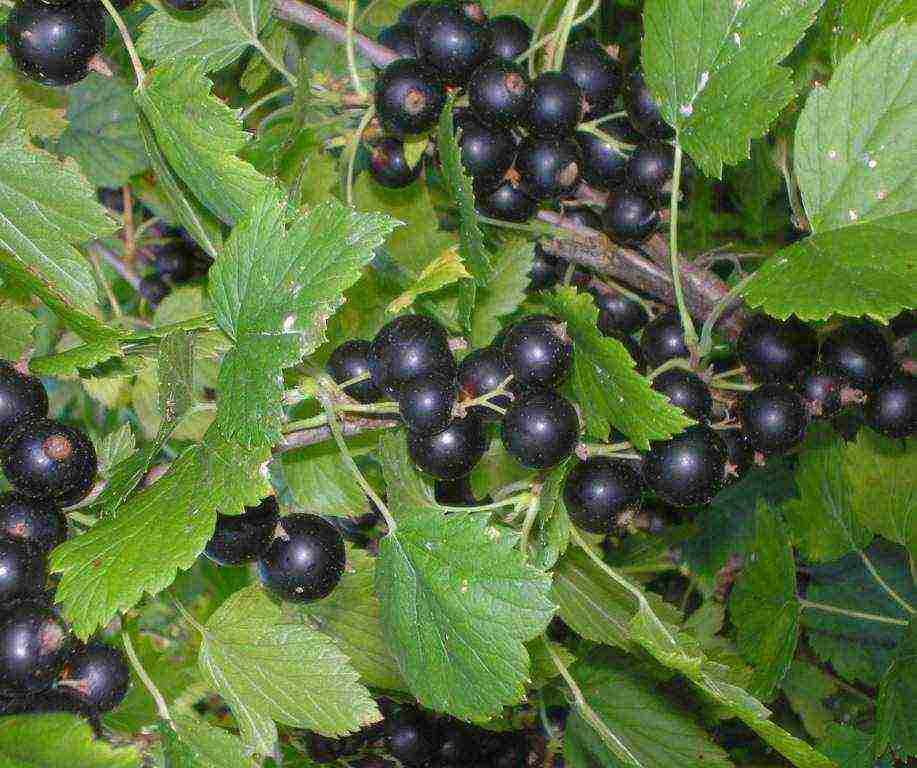
Vologda entered the State Register in 1995 for cultivation in the North-West, Central, Volgo-Vyatka, Middle Volga and Far Eastern districts.
The bush is medium, spreading, rather dense. Dark green, large, asymmetrical leaves are bent down. Medium-sized flowers are collected in clusters.
Fruits are black, round, weighing up to 3 g. The pulp is juicy and tender, covered with an elastic skin, has a sweet and sour taste and a pronounced aroma.
100 g of fruit contains:
- sugar - 7.5%;
- vitamin C - 175 mg.
Taste is rated on a five-point scale at 4.5 points.
The variety is hardy, easily adapts to any weather conditions. Fruit shedding is absent. The yield is high - up to 4 kg per plant. Vologda is highly transportable.
Advantages:
- frost resistance up to -28 degrees;
- high productivity;
- excellent taste and marketability;
- good keeping quality and transportability;
- large-fruited;
- disease resistance.
Flaws:
- bushes require support;
- fruits crack when overripe;
- uncooked ripening of berries.
Mermaid
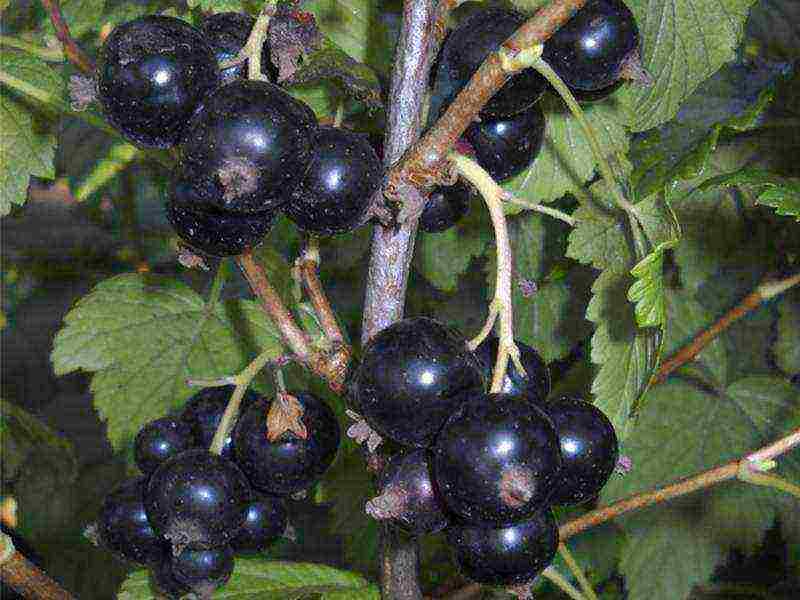
The variety was included in the Gosrestr in 2004. It is successfully cultivated in the middle zone and the Central region of Russia.
Plants - medium-sized, spreading, medium thickening. Leathery, shiny leaves of large size, have a dark green color. Small light pink goblet flowers are collected in a brush.
The berries are simply huge, up to 7.5 g each. Juicy tender pulp has an excellent sweet dessert taste. Productivity - up to 3 kg per bush.
100 g of pulp contains:
- sugar - about 10%;
- acids - 1.6%;
- vitamin C - 186 mg.
Plants are susceptible to septoria disease and kidney mite attacks. The variety is self-fertile, frost-hardy, resistant to powdery mildew and anthracnose.
Advantages:
- high productivity;
- large-fruited;
- frost resistance;
- drought resistance;
- excellent taste.
Flaws:
- susceptibility to septoria disease and kidney mites.
Large-fruited varieties
In addition to the above, large-fruited include:
- Dobrynya;
- Nuclear.
Dobrynya
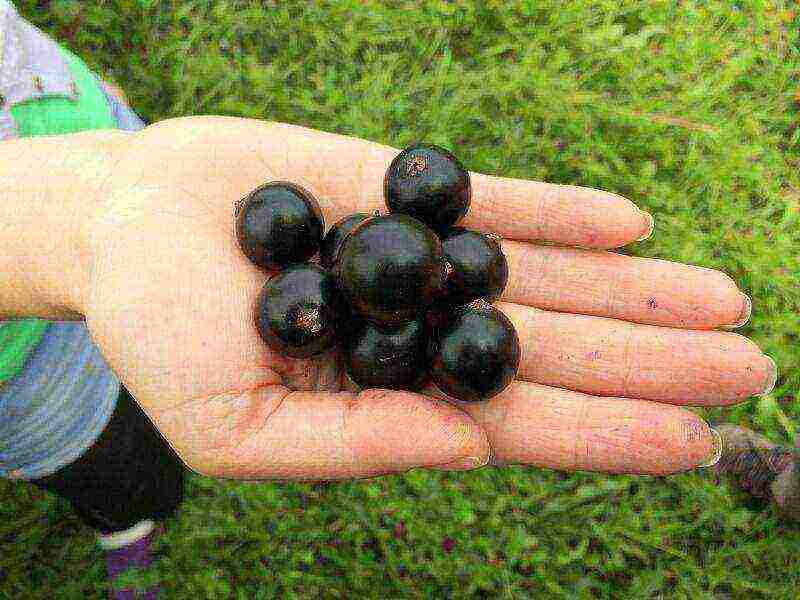
The mid-season hybrid Dobrynya was entered in the State Register in 2004 for cultivation in the Central and West Siberian districts.
Bushes of plants are compact, medium-sized. The bright green three-lobed leathery leaves are large in size. The flowers are also large, white-yellow, collected in inflorescences. The variety begins to bloom at the end of April. Flowering lasts 10 days.
The berries are black, with a blue tint, weighing up to 7 g, and are very large in size. The pulp is juicy. The skin is firm and elastic. The taste is sweet and sour, harmonious.
100 g of berries contain:
- sugars - 6.9%;
- acids - 2.5%;
- vitamin C - 200 mg.
On a five-point scale, taste is rated at 4.8 points.
The variety has good, up to -25 degrees, frost resistance and an average yield, up to 1.6 kg per plant.
Advantages:
- large-fruited;
- stable yield;
- frost resistance and drought resistance;
- good transportability and keeping quality of fruits;
- excellent taste;
- high resistance to powdery mildew.
Flaws:
- uncooked ripening of berries;
- susceptibility to fungal diseases and anthracnose, as well as kidney mites.
Vigorous
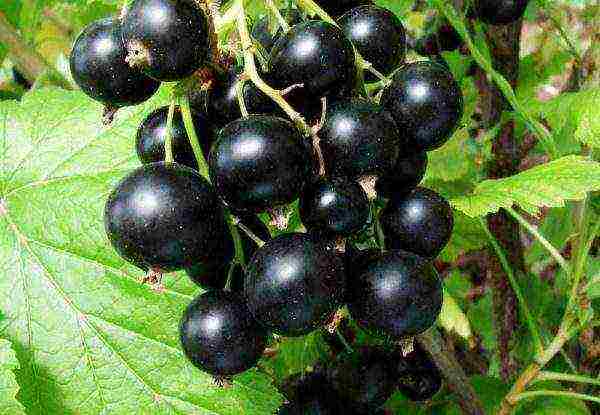
One name speaks for itself!
The variety was registered in the State Register in 2000 for cultivation in the West Siberian and Volgo-Vyatka regions.
The bush of the plant is medium-sized, with a small amount of foliage. Long branches are simply covered with large berries. Leaves are large, dark green, matte. Flowers are small, white and pink.
Berries are black, plum-like, very large, weighing up to 8 g, have a pleasant, refreshing, slightly sour taste.
Composition of 100 g of fruits:
- sugar - 9%;
acid - 3.7%; - vitamin C - 96 mg.
The variety is late. Flowering begins in late May, and the berries begin to ripen in mid-July. The kernel is characterized as a type of black currant that is resistant to weather disasters. He doesn't care about heat or drought. The yield is also amazing - up to 6 kg are harvested from one bush.
Advantages:
- large fruits;
- rich harvests;
- good frost resistance;
- high resistance to kidney mites and powdery mildew;
- resistance to weather extremes.
Flaws:
- whimsical care;
- poor transportability;
- poor resistance to anthracnose.
Sweet varieties
Sweets include:
- Nina;
- Excellent student.
Those types of black currants are considered sweet if they contain 11 percent or more sugars and a minimum of acids.
Variety Nina
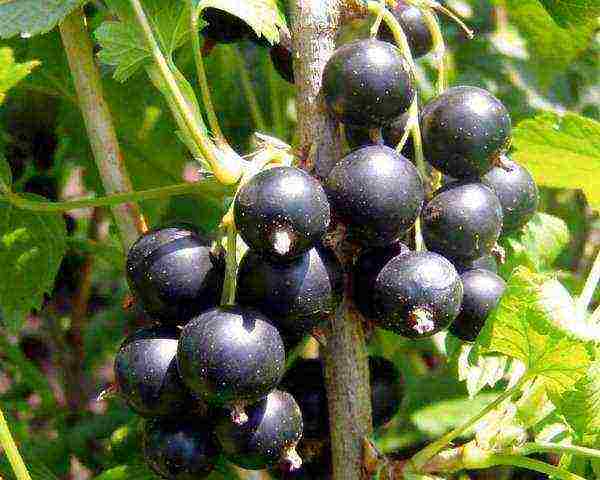
Nina is a mid-early high-yielding variety cultivated in the Central and Volga-Vyatka regions.
Bushes of plants are short, compact, rather dense. The leaves are large, leathery, dark green in color. Berries are black, medium in size, weighing up to 1.5 g.
Composition 100 g:
- sugar - 11%;
- vitamin C - up to 270 mg.
The variety is frost-resistant, high-yielding (up to 3.5 kg per bush).
Advantages:
- high sugar and vitamin C content;
- high self-fertility and productivity;
- excellent powdery mildew resistance.
Flaws:
- berries are practically not stored and transported.
An excellent pupil
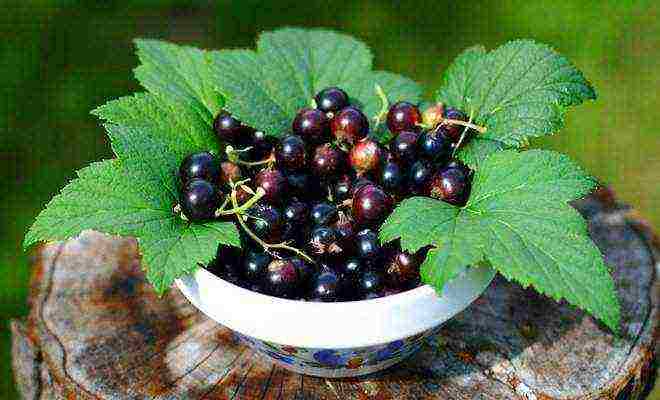
The variety has the highest sugar content. Cultivated in the Central regions, Volgo-Vyatka and North-West regions of the country.
Plants - vigorous, vigorous, with spreading dense branches. The leaves are three-lobed, light green in color, of medium size. Berries are black, large, weighing up to 2 g. Taste is rich-sweet, with a slight sourness. Ripening - amicable, falls in mid-July.
100 g of pulp contains:
sugar - about 12%;
vitamin C - 230 mg.
Yields are high, up to 4.5 kg per plant. Differs in high frost resistance, and is resistant to spring frosts.
Advantages:
- high productivity;
- high sugar and vitamin C content;
- resistance to weather extremes.
Flaws:
- poor resistance to morbidity.
All the varieties listed above are worthy representatives of the culture called black currant. Any of them will decorate with dignity a garden plot located in central Russia and not only there. Delicious and aromatic berries will perfectly complement the daily diet of any table. The choice is yours!
Throughout Russia, black currant grows near every house. Undemanding to the composition of the soil, accustomed to harsh winters, it yields even in the subarctic zone... This garden culture bears fruit even in Yakutia and the Khibiny, reached Sakhalin in the east and Krasnodar Territory in the south.
She inherited such a universal adaptation to the whims of the weather from a wild ancestor - the forest currant. There are a lot of varieties and varieties, so it is very difficult for a novice gardener (and not only) to make a choice.
Choosing varieties for central Russia
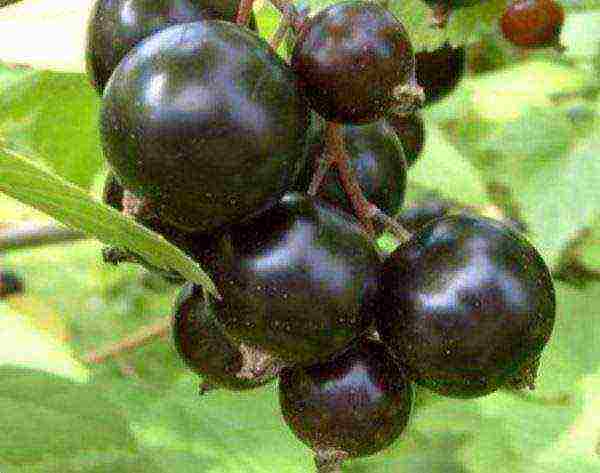 Early variety of black currant Exotic
Early variety of black currant Exotic
What are the differences between the varieties:
- By appointment,
- Ripening terms,
- The size of the berries,
- Productivity,
- The taste of berries
- Resistance to diseases and pests,
- Winter hardiness ...
It is very easy to understand the purpose of the variety:
- berries are tasty on their own - this is a dessert variety,
- thin-skinned, but too sour - boil jam or grind with sugar;
- berries with a dense strong skin are frozen,
- universal (understandable).
In order not to be mistaken, it is necessary to choose only zoned varieties.... Only on such bushes can you get a high yield stably and without much effort.
Ripening terms, size of berries, their taste may differ not only from the region of cultivation, but even from watering or soil composition. Already at a distance of more than 200 kilometers, the characteristics of the variety can change significantly.
If you live in the middle lane, you should take a closer look at these varieties:
| Curiosity, Selechinskaya, Exotic, Openwork, Summer resident, Orlovia, Exotic |
| Black pearl, Loyalty, Perun, Green haze, Zusha |
| Kipiana, Vigorous, Venus, Mermaid |
Among the fruit-bearing ones, the Selechinskaya, because he combined the best qualities of his ancestors - wild currant and gooseberry.
Most varieties have an Achilles heel - they cannot grow without abundant watering. But Selechenskaya calmly copes with both summer drought and frosty winters, which makes its choice suitable for any region of Russia.
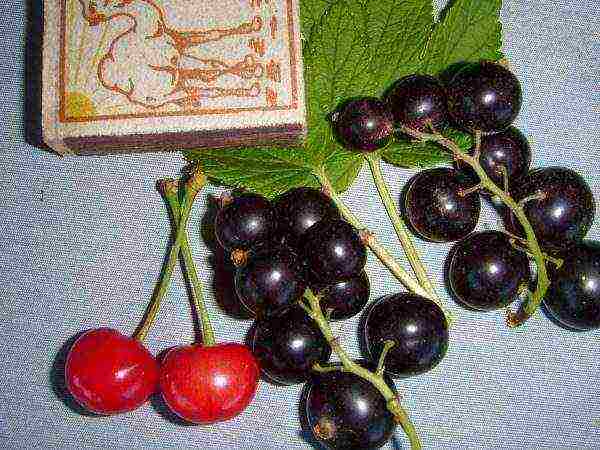 An early variety of black currant Selechenskaya
An early variety of black currant Selechenskaya
To all this, also add five kilograms from a bush of large berries the size of a cherry... There are no special advantages in varieties intermediate between early and late ones. They give fewer berries, and this is not because the varieties are not good enough.
It's just that the period of their fruiting falls on the period of summer heat and dry wind.
The main purpose of these varieties is to fill a niche in front of the later, most productive varieties.
Ripening of late varieties of berries lasts from late July to. the end of autumn. Wherein Kipiana variety has a yield of up to 5 kg and is resistant to powdery mildew and is not afraid of kidney mites.
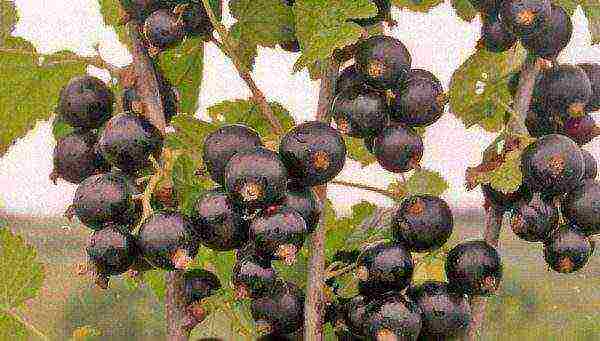 Late black currant Kipiana
Late black currant Kipiana
Vibrant yields late, but these berries can compete even with grapes in size - even 8 grams... There is a known case when an experienced gardener had a berry reached the size of a metal ruble!
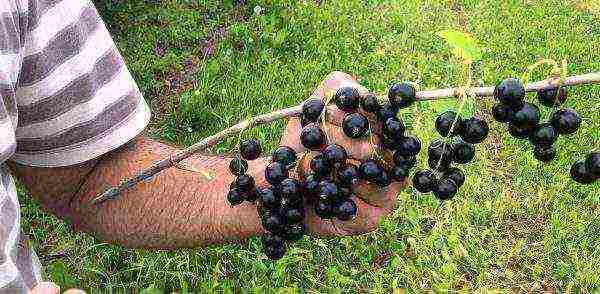 Late variety of black currant Yadrenaya
Late variety of black currant Yadrenaya
The Viper bush usually yields almost 4 kilograms of berries.... The popularity of the variety is also due to its resistance to pests and fungal diseases.
Currant for Siberia
Siberia is known not only for its harsh winters, but also for its hot dry summers. These stressful weather conditions are easily tolerated by the zoned Siberian varieties:
| Lama, Nika, Gift to Kuzior |
| Altayanka, Agatha, Galinka, Rita, Spherical, Fun, Prestige, Ksyusha |
| Mila, Harmony |
New varieties successfully withstand not only frost, but also arid heat. They are able to withstand major fungal diseases and insect pests.
In terms of early maturity, the specified varieties also set records: the first harvest from the currant bush of the new Nika variety reaches 1.2 kilograms.
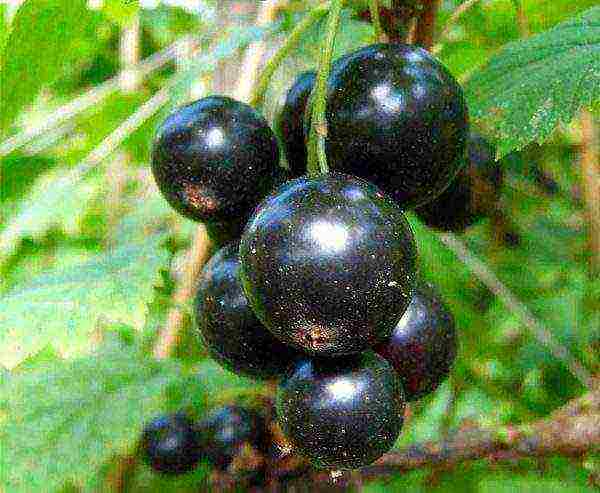 Nick's early blackcurrant variety
Nick's early blackcurrant variety
Berries of Siberian currant Large-fruited Litvinova even reach 6 grams!
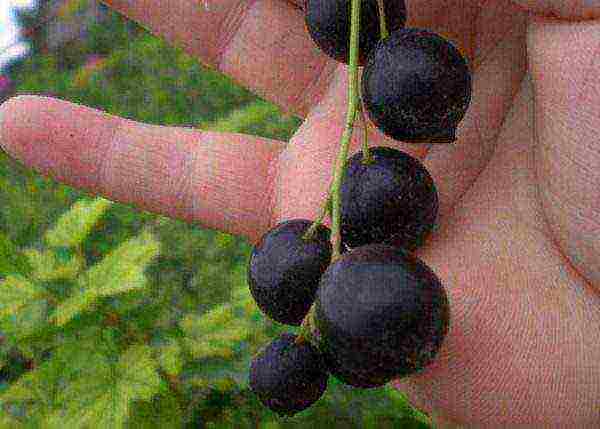 Blackcurrant Large-fruited Litvinova
Blackcurrant Large-fruited Litvinova
What are the largest-fruited varieties?
Undoubtedly, varieties of unusually large berries will become the leaders of the list.
| Vigorous | medium late variety for universal use berries from 3 to 8 grams non-uniform, yield 3-6 kilograms per bush, non-uniform fruits, aging quickly |
| Dobrynya | universal purpose, bears fruit in the second half of July, berries up to 7 grams are also non-uniform, almost five kilograms can be removed from the bush |
| Selechenskaya-2 | universal variety, bears fruit in early July. Berry picking - up to 5 kilograms per bush |
The best large-fruited varieties: Vigorous, Selechenskaya, Globus, Pygmy.
When choosing a super-large-fruited variety, one should not forget that usually such plants require additional feeding and watering, especially in dry summers and if they are planted on sandy soils.
The most resistant varieties
They practically do not get sick, which means - the harvest is ecologically cleanest among the varieties:
- drought tolerant - Dobrynya, Gulliver, Izumnaya;
- disease resistant - Sibylla, Gross, Gamma, Gulliver, Sevchanka, Globus, Muravushka;
- frost-resistant - Sibylla, Venus, Romance, Globe, Pearl, Rhapsody, Vigorous;
- pest resistant - Orlovia, Kipiana, Grazia, Gamma.
Gourmets also have plenty to choose from
If the score is higher than 4.5 points, the variety is assigned to the dessert category: Centaur, Perun, Selechenskaya, Selechenskaya-2, Nadia, Venus, Oryol waltz, Slastena, Beaumond, Nestor Kozin, Tisel, Uralskaya sweet, Raisin, Black eye.
The Izumnaya variety has an interesting feature: after ripening, the berries do not crumble from the stalk, but gradually "rave", hence the name of the variety.
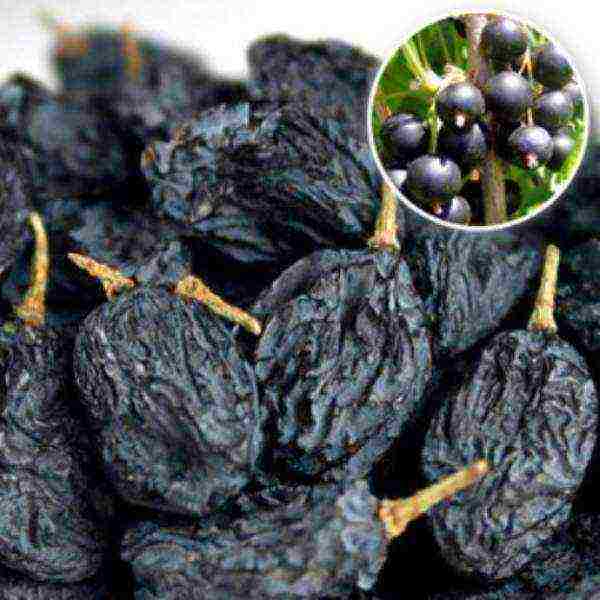 Black currant Raisin
Black currant Raisin
Best-tasting early varieties - Pearl, Black Boomer, Raisin, Legend.
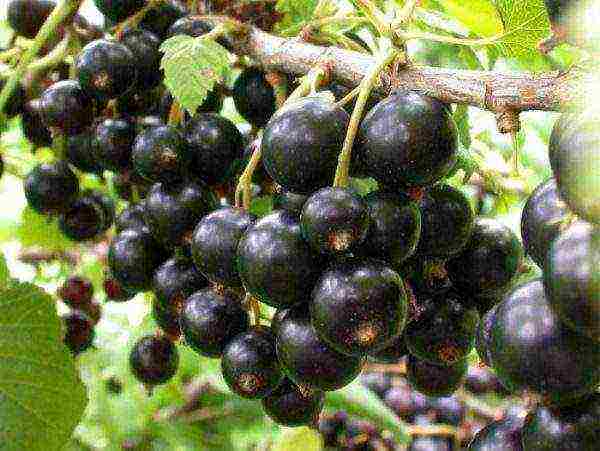 Currant Black Boomer
Currant Black Boomer
Lazy person - late variety with very large berries up to 6 grams.
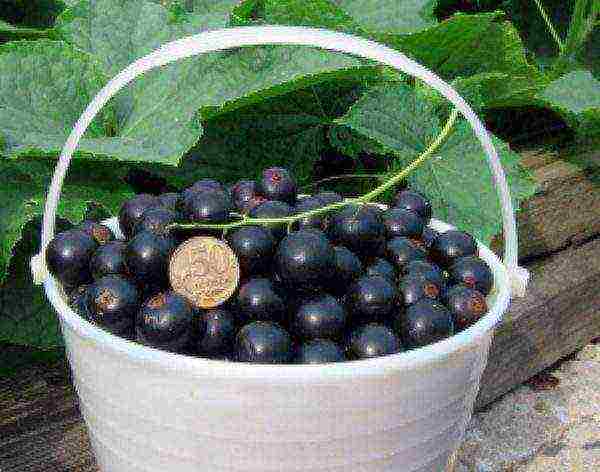 Blackcurrant Lazy
Blackcurrant Lazy
What's new for residents of the Moscow region?
The weather in the Moscow region is characterized by relatively mild winters and rather warm, humid summers. This is the climate that black currants like. However, the soil composition differs even in the districts of the Moscow region.
It is necessary to select varieties not according to yield or taste, but exclusively, adapted to the specifics of the soil composition of the region.
The most famous varieties among summer residents: Veloy, Memory Lisavenko, Sudarushka, Dobrynya, Yadrenaya.
To feast on berries all season, you must choose from the following varieties:
| Sevchanka, Nara, Moscow black, Dar Smolyaninova, Golubichka, Selechenskaya, Selechenskaya-2 |
| Dobrynya, Green haze, Darkie, Oryol serenade, Daughter, Izmailovskaya, Paulinka, Perun |
| Vologda, Lazy, Veloy |
It should be noted that late varieties for the Moscow region are far from the best choice. Summer residents simply may not have time to take advantage of all the best qualities of the same, for example, Lazy - the berries may not ripen.
The Yadrenaya variety, as already noted, was highly appreciated by summer residents for many literally unique qualities:
- high yield,
- very large plum berries,
- compact bush,
- self-fertility,
- winter hardiness,
- early maturity.
Even if you are overwhelmed by the size and flavor of the berries, there are still some characteristics you need to figure out.
What characteristics should you pay attention to first of all:
- self-fertility (no additional pollinator required),
- susceptibility to diseases and pests,
- resistance to spring frosts and other weather factors.
If you plant several varieties nearby (even self-fertile ones), there will be much more berries.
Therefore, stress-resistant Gulliver will not create problems with weather whims, and Smolyaninova's gift will delight you with an early harvest even without chemical treatments for pests and diseases.
 Black currant gulliver
Black currant gulliver
Another gift for fans of ecological products - variety Orlovskaya serenada, which is practically not afraid of kidney mites , and from fungal diseases - powdery mildew.
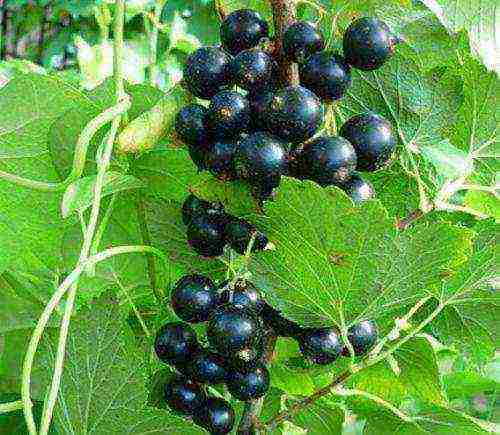 Black currant Oryol serenade
Black currant Oryol serenade
The Selechenskaya-2 variety with its increased ecological plasticity, will not be afraid of a lack of water and unsuitable soils... As a result, the summer resident will receive from the bush his required 5 kilograms of berries the size of a cherry.
Conclusion
It is very difficult to choose the right variety of black currant bush., but there is a correct solution to this problem for an ordinary summer resident. This is to acquire zoned modern varieties of different ripening periods. Their high yield, unpretentiousness, harmonious taste have already found confirmation in personal plots throughout the country.
Currants are a favorite garden berry. In our country, it is grown everywhere.This culture has gained popularity due to its taste, nutritional and healing properties. Breeders have bred thousands of varieties of different currant colors. Each of them has its own characteristics.
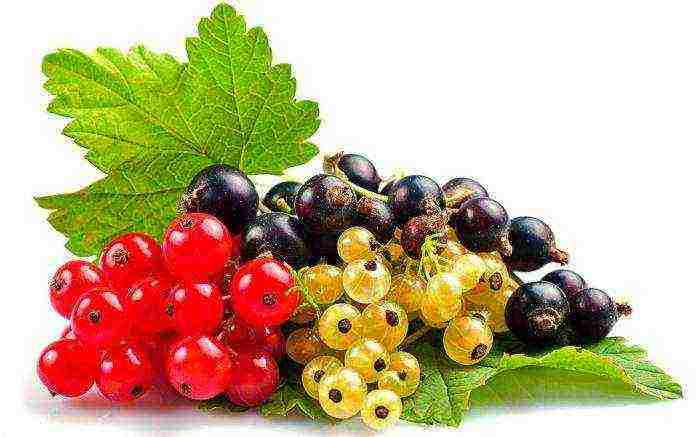
Currant varieties
Currants, like other crops, come in different varieties. Each of them has its own specific shape, size, color of berries, pulp consistency, taste, aroma and much more.
Currant varieties differ from one another in the size of the fruit clusters and the density of the berries on them. And different ripening periods allow to increase the period of fresh berries consumption.
Red and white currants
Usually currants of these two flowers are considered as one crop, since the berries differ only in color. Red currants were known as early as the 5th century. It was grown by the Dutch for beauty. First of all, its decorative qualities were appreciated, the berries were of no interest. The red currant has become very popular in Europe. In Russia, they got acquainted with this culture only in the 15th century.
White currant became known much later. At the beginning of the last century, it was considered one of the varieties of red currant with an atypical berry color for this species. These two varieties do not have a pronounced aroma, but differ in taste and useful properties. The best varieties of white and red currants are unpretentious to growing conditions, but they feel better on loamy and sandy loam soils. These are very light-loving plants, undemanding to moisture. It should be remembered that with a lack of lighting, the berries lose their taste and color. The culture is resistant to disease and damage.
With proper care, these two varieties of currant produce high yields. Bushes covered with red and white berries look very beautiful. Fruit formations of white and red currants are more durable than black ones, the berries are evenly distributed over the bush, they are less thickened by shoots. The plant can bear fruit for 15-20 years, growing without transplanting to another place.
Red currant: varieties
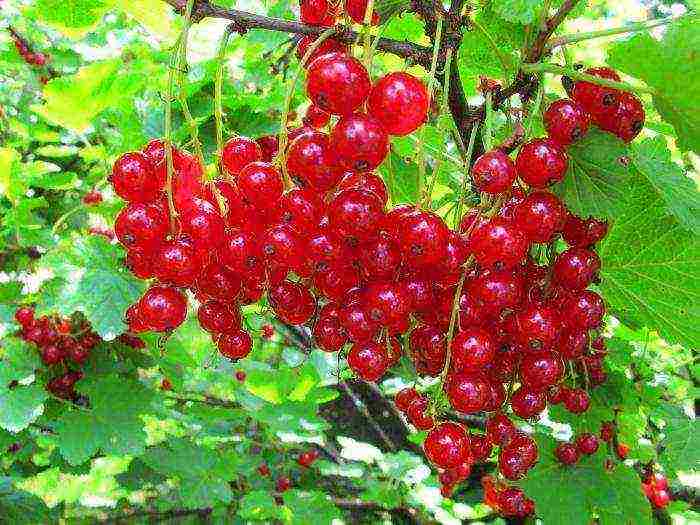
- "Varshevich" is distinguished by the originality of the color of the fruit. They have a pronounced dark purple color. It is a self-fertile variety that ripens late. On a large, powerful bush, many fruits of a round or slightly compressed shape are formed. Medium-sized berries with juicy purple flesh have a sour taste and form a long cluster. Ripe fruits remain on the branches for a long time. For its high yield, unusual fruit color and decorative effect of the bush, this variety of currants is popular with gardeners. Fresh berries are used less often, more often they are processed.
- "Nenaglyadnaya" is a variety that has an average ripening period. The bush is characterized by small size, medium branching and thick, straight stems. The rounded berries are bright and medium in size. There are many of them on the brushes, and they are evenly distributed. The fruits of sweet and sour taste have a universal purpose. This variety is not afraid of severe frosts, it has a high yield and is not affected by powdery mildew.
- A typical representative of a medium-ripe variety of currants, the photo of which you see above, is "Svetlitsa". The bush is medium in size, compact and erect shoots. The rounded berries are not large in size, but very juicy and tasty. This variety, despite its small berries, gives high yields and is not susceptible to fungal diseases.
Large-fruited red currant
- "Chulkovskaya" red currant belongs to an old variety, which even today attracts the attention of amateurs and specialists of this type of culture by its early ripening and taste of the fruit. The red currant variety differs in the small size of the bush. The best varieties include Chulkovskaya currants. Long brushes are strewn with large red berries, round or pear-shaped.They are distinguished by tender, juicy pulp and sweetish taste. Ripe berries, without crumbling, remain on the branches for a long time. This sweet variety of currant consumed fresh or processed.
- Variety "Jonker van tete" has a medium-early ripening period. This Dutch currant variety was bred in early 1941. In our country, it gained popularity in the nineties of the last century for its excellent taste and resistance to disease and damage. This variety gives high yields and is resistant to low temperatures. Differs in a powerful, large, dense bush of red currant varieties. The best varieties include this particular species. On long or medium-sized clusters, you can count up to ten very large, bright berries. The shape of the fruits is round or pear-shaped, they are covered with a dense, elastic skin. The pulp is juicy and very tasty. Therefore, this currant is so fond of eating fresh.
- The large-fruited currant of the "Uralskaya krasavitsa" variety is one of the best varieties of domestic selection. Differs in low spreading bushes and disease resistance. Therefore, the leaves are preserved until the first frost. The culture belongs to the early ripening period. The disadvantage is that the yield increases gradually, in direct proportion to the long-term growth of wood. The berries are distinguished by their large size, excellent taste and pleasant aroma.
White currant: varieties
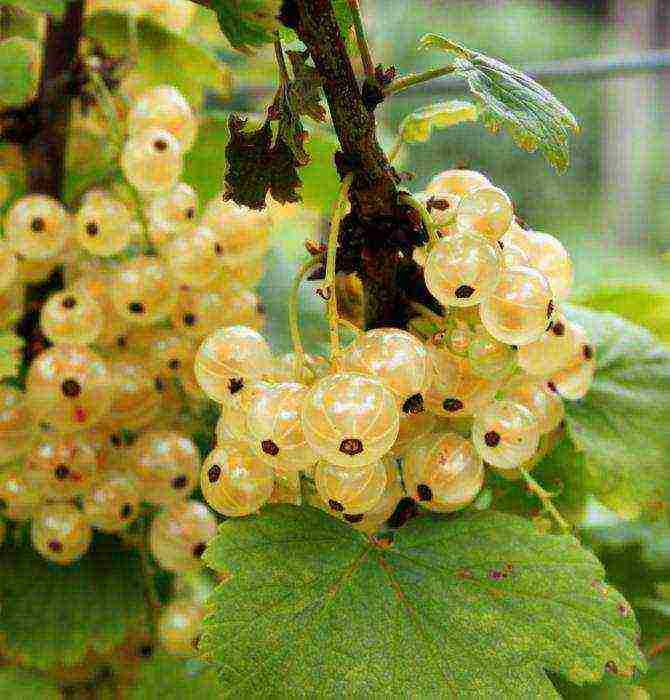
- "Jumping" is a type of white currant and has an average ripening period. The bushes of the plant are distinguished by medium growth vigor, branches are spreading, with a bountiful harvest they sag and fall. On clusters of medium length, there are usually many not very large berries of a light pink color, round in shape. Sweet and sour fruits have a universal purpose. Ripe berries remain on the tassels for a long time, do not crumble. At this time, they intensively acquire taste. White currant of the "jumping" variety is ideal for freezing. This variety bears abundant fruit and has an excellent taste.
- "Dutch" white currant belongs to an old variety, but recently it has been persistently replaced by other, more promising species. Although many gardeners believe that in vain. The bushes of this plant are not very sprawling, compact, which allows them to maximize the use of the area of the site when planting them. This variety of currant bears fruit better in moist, fertile soil, resistant to low temperatures. The berries are medium in size and have a rounded, slightly compressed shape. Their skin is transparent. Seeds and veins on the surface are clearly visible. The pulp is juicy and delicious. Ripe berries do not crumble, they are harvested in one step. This currant is good fresh. But its processing will not affect the taste.
- The versailles white currant is well known to gardeners who breed it on their plots. It is attractive for its high yields and tasty, large-sized berries. Its bushes are compact and medium in size. This currant gives high yields, growing on fertile soils. It tolerates frost well. According to the ripening time, it belongs to the middle varieties. Large berries are light cream in color and rounded. In the process of growth, they hardly change in size. Their skin is transparent, seeds and veins are visible through it. The pulp is very juicy, sugar and acid are harmoniously combined in it, which gives the fruit a refreshing taste. The berry is especially good when fresh. In addition, jams, compotes, juices, syrups, jams and much more are made from it.
Red currant: benefits
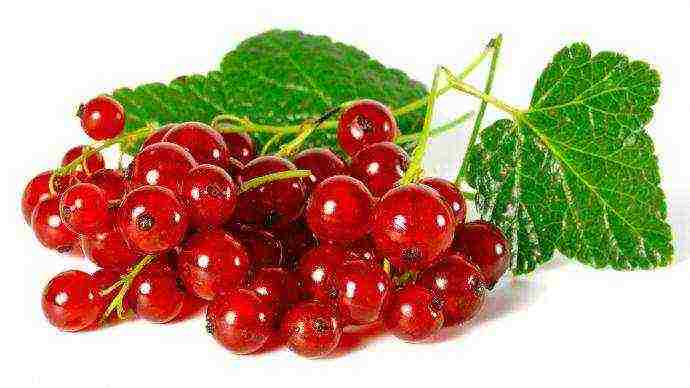
Red currant berries are rich in potassium, iron, succinic and malic acids. They contain pectin and carotene. The use of berries promotes the elimination of excess fluid from the body, serves as a prevention of heart and vascular diseases.
Red currant fruits are used in the treatment of diabetes mellitus. They eliminate nausea and stimulate appetite. They are used as a diuretic, anti-inflammatory, hematopoietic, laxative and tonic. The use of malic and succinic acids contained in berries energizes the body. Therefore, it is recommended to use them for elderly people. Red currant juice maintains the tone of the body at the proper level.
Red currant harm
The benefits of red currants are obvious and indisputable. But with some diseases, it can be harmful. In this case, it must be excluded from the diet. Drinking juice is categorically contraindicated for people suffering from stomach ulcers, hepatitis, gastritis and low blood clotting.
Black currant
The name of this type of culture comes from the word "currant", which translated from Old Russian means "persistent smell" characteristic of this species. The black currant is to the liking of gardeners, and its delicious berries have long been loved by children and adults. Description of currant varieties provides a wide choice of crops. After all, this plant is characterized by resistance to low temperatures and fungal diseases. Black currant is a fast-growing, high-yielding crop with annual fruiting. It does not have great requirements for growing conditions. And its berries have excellent taste and healing properties.
Black currant: varieties
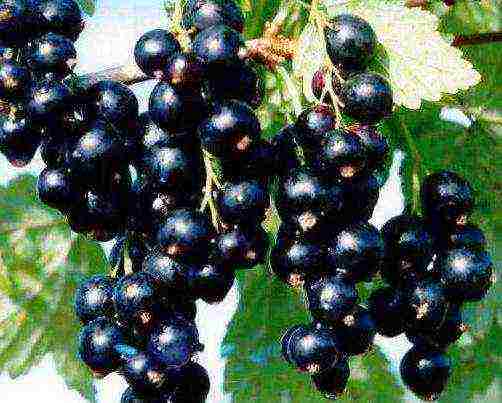
- "Little Prince" is an early variety. It features a low bush and its convenient shape, which simplifies harvesting. It is resistant to all diseases, severe frosts and prolonged drought. Bears fruit regularly and abundantly. The berries on the tassels are densely arranged and ripen at the same time. This makes them easier to collect. Brushes are small in size, there are paired and single. The berries are juicy, bright black in color, covered with a thin delicate skin. Lovers of sweet and sour fruits will love them.
- "Openwork" black currant is a highly self-fertile variety. It is frost resistant. He is not afraid of abrupt weather changes. The intense heat does not oppress him. It bears fruit regularly and has a consistently average yield. This culture is resistant to powdery mildew and anthracnose diseases. But sometimes it is affected by kidney mites. Curved thick tassels are short to medium in size. The rounded berries are large, shiny and have a sweet, sour taste. If you choose which varieties of currants are better, you can stop at this.
- "Bagheera" belongs to a late variety and is distinguished by high frost resistance and abundant harvests. There is a slight freezing of shoots if frost and thaw often alternate. This variety is not damaged by terry and anthracnose, but powdery mildew can sometimes harm the plant. Fruits are evenly distributed on thin small branches. The berries are of the same size and have a pronounced black color. The shiny, thin skin is very tough. The fruits have a delicate aroma and sweet taste.
Large-fruited black currant
- "Exotic" is the largest-fruited variety of black currant. Differs in high yield and early ripening. The bush is powerful, vigorous, erect branches, strong. Do not bend from the weight of large berries, which form a brush evenly. The fruits are juicy and have a pleasant sweetish taste. The best varieties of black currant are represented by this type of culture.
- "Aleander" refers to varieties of large-fruited black currant. Differs in a tall, spreading bush and branches lying under it. The leaves are dark green, strong and slightly wrinkled. The plant is resistant to powdery mildew and anthracnose, but prone to damage by bud mites. The culture of this variety of currants tolerates the harsh winter months, but drought is not a comfortable condition for its growth and abundant fruiting.There are many large berries on long, thick, arched clusters. They have a pleasant taste and fragrant aroma.
- "Selechenskaya-2" is one of the best varieties of black currant. Tall, compact bushes have many strong branches that do not need a garter. This variety is not afraid of fungal and tick-borne diseases. Very rarely, it is affected by a kidney mite. This is a versatile variety that tolerates severe frosts and prolonged heat. There are many very large gooseberry-like berries on strong, curved clusters. The fruits are covered with a firm, thick skin. They are not torn during harvest. The berries are tasty, sweet, and have a peculiar delicate aroma.
Useful properties of black currant
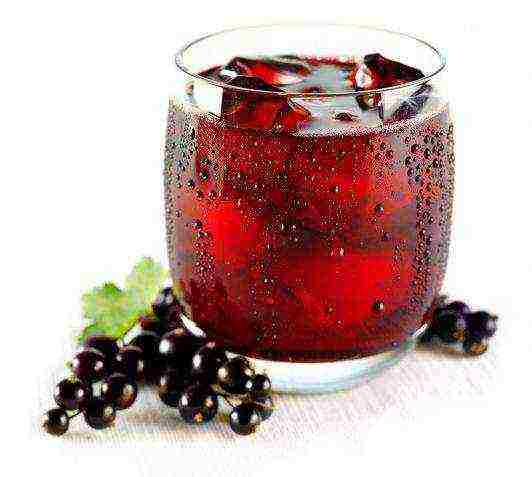
The description of the varieties of currants will not be complete, if not to say about their benefits. Black currant is the healthiest berry in existence. It is called the pantry of substances necessary for a person. It has an excellent taste and is appreciated for its high healing properties. The berry contains a large amount of ascorbic acid, carotene and biotin, which is called the vitamin of youth.
Black currant has long been widely used in folk medicine. The content of iron, potassium and magnesium allows the use of fruits and leaves for anemia, vascular and heart diseases. Black currant is rich in pectins, phytoncides, essential and tannins.
The berry of this variety of currants lowers cholesterol levels, treats eczema and skin diseases, helps with depression and stress. Ulcers and gastritis are treated with flowers and young leaves of black currant, and rheumatism and kidneys are treated with berries. Currently, there are thousands of recipes for various diseases based on black currant.
Diseases of the currant
Currants, like other plants, are affected by diseases and damaged by pests. If you plant the best varieties of currants on your site, you can avoid infection with many infectious diseases. But you need to know the most common ones.
- Anthracnose is a disease of leaves, their petioles, stalks and fruits. It affects plants starting in May. It is characterized by the appearance of small brown spots, which grow over time. The leaves begin to turn yellow, curl and fall off. Shoots slow down growth and do not have time to ripen. To prevent the disease in early spring and late autumn, you should dig up the ground around the bush. And before the buds bloom, spray with a solution of vitriol. You can apply Bordeaux liquid. It is sprayed four times during the growing season: during the budding period, at the end of flowering, half a month after flowering, after harvesting.
- Terry is a viral disease and therefore can spread quickly. Carriers are bed bugs, kidney mites and aphids. This disease is characterized by a change in the shape and color of leaves and flowers. The plant stops bearing fruit. To combat the disease, branches are cut or the entire bush is removed. The main thing is to fight the spread of the disease.
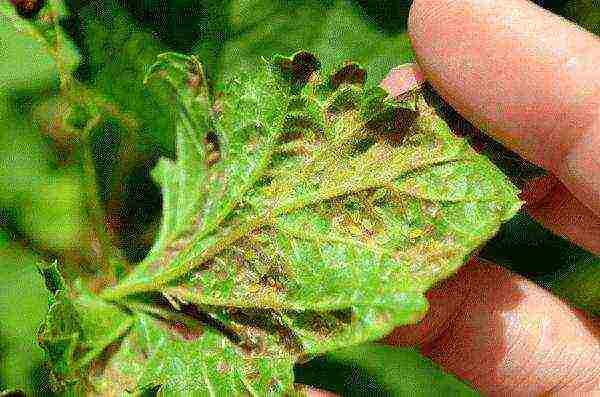
Currant pests
- The kidney mite is very small and can only be seen through a magnifying glass or loupe. It damages the buds of the plant, which acquire a spherical shape and do not release leaves and flowers. The mite waits out the winter in its buds. It spreads through planting material, birds and insects. Effective means of combating this pest have not yet been invented. But the struggle must be waged. To do this, the plant is sprayed several times: before bud break, two weeks after it and before flowering. There are a lot of solutions for spraying. In any store, they are presented in a large assortment.
- The sawfly has a good appetite. He eats all the leaves. Its larvae are in cocoons, which are buried in the ground under a plant bush. Here the pest waits out the winter.The fight against him is in the autumn digging and spraying in several stages: when buds open, buds are formed, at the end of flowering. To prevent the pest from multiplying, its larvae are periodically shaken off and burned.
